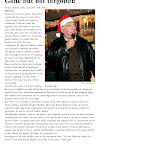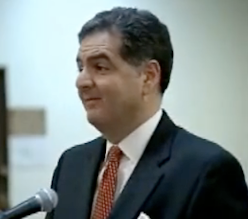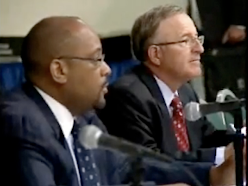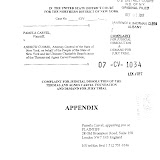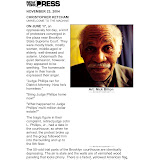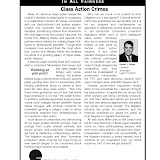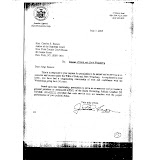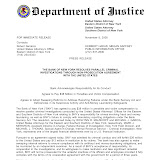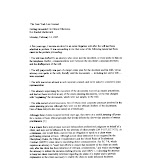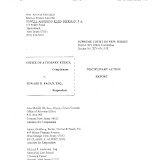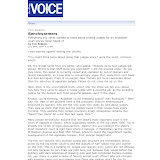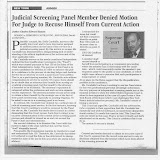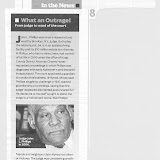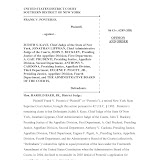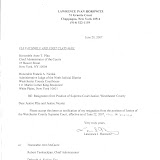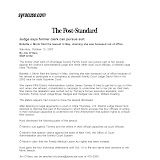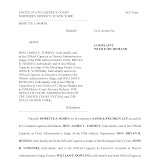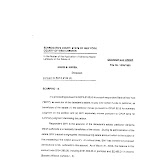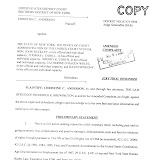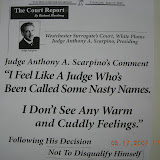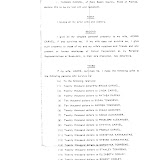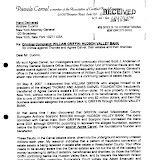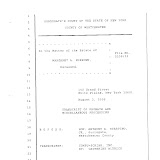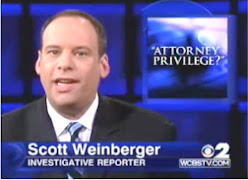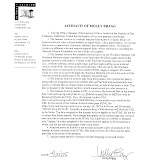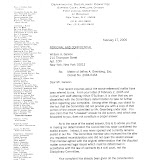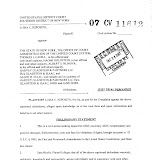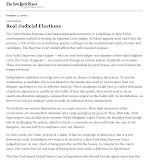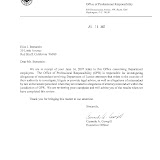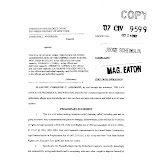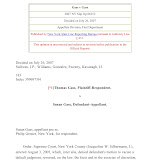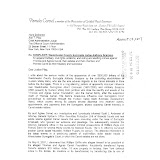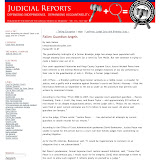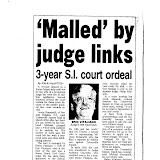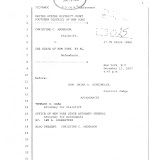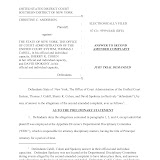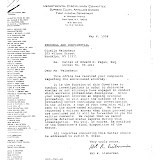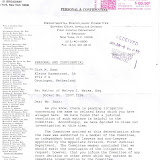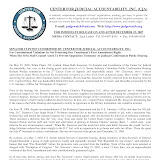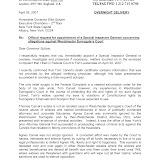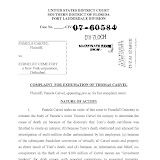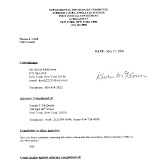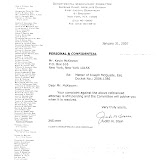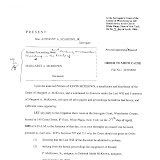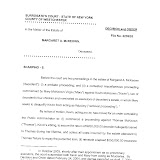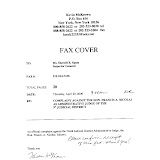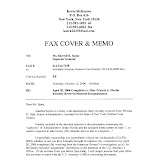Assistant Bronx DA Jennifer Troiano may have skirted hot water before
The New York Daily News by Alison Gendar, Kevin Deutsch and Rocco Parascandola - April 30, 2011
A Bronx prosecutor who got a DWI arrest voided may have skirted hot water before - sources said she was involved in a wreck upstate in a city vehicle and never got into trouble. A police source familiar with the investigation alleges Assistant District Attorney Jennifer Troiano was driving a car in 2005 when she got involved in a wreck. Jose Arroyo, a detective assigned to the district attorney's office, was asleep in the passenger seat, the sources said. Since no one was arrested, there are no public records that definitively show who was driving. A bumper and a license plate were left at the scene, the police source claims. Authorities traced the car back to the district attorney's office. Still, the teflon prosecutor described by one colleague as a "wild child" wasn't charged with a crime or disciplined by her supervisors. "She knows the right people and keeps getting out of jams," a law enforcement source said. "She's not getting away with that if she's not an ADA." Prosecutors yesterday had little to say about the 2005 wreck. "Yes, we are aware of an accident involving Ms. Troiano and an NYPD detective," said Steven Reed, a spokesman for the Bronx DA's office. He wouldn't comment further and Troiano's lawyer didn't respond yesterday to the allegations surrounding the 2005 crash. Arroyo was suspended, brought up on departmental charges and left the force, a police source said. Years later, his life took an even more sinister turn. In November 2008, he drugged a woman at a Bronx bar, took her to a motel in Westchester and raped her. Arroyo, 49, is serving a 15-year prison sentence. Troiano, 34, is a graduate of Cardozo Law School. She has worked several notable cases as a prosecutor - including a housing voucher fraud case. She also prosecuted a teen who was charged with killing a cat by cooking it in an oven last year. On August 26, Troiano planted the seeds of her now public problems when she was charged with driving drunk on the Major Deegan Expressway. Police said she caused a three-car wreck. During the investigation of that wreck, her bosses learned that Troiano had previously been detained and released after cops suspected she was driving drunk while leaving a Christmas party in 2009. Sources said Troiano was handcuffed and brought to the 44th Precinct stationhouse where she identified herself as a prosecutor. A cop voided the arrest, the sources said. A high-ranking police official said yesterday that the Bronx DA's office never contacted the NYPD's Internal Affairs Bureau. Police officials learned of the allegations about Troiano when the media began asking questions on Thursday. The Bronx district attorney's office is leading a probe into alleged ticket-fixing that is expected to result in the indictments of about 40 cops - many of them union delegates. "The image this projects is: 'If they're not going to discipline their own people how can they go after cops?'" a police source said. Police Commissioner Raymond Kelly said the Internal Affairs Bureau is reviewing precinct logs and computer records to figure out who voided the 2009 arrest. "We're investigating that allegation," Kelly said. "We haven't been able to find anything in our records about that supposed stop." Meanwhile, The News learned that Bronx prosecutors are beginning to discuss plea deals with dozens of suspects because the cops involved in their cases are linked to alleged ticket-fixing. "It's serious damage control," one prosecutor said. "These are good cases that aren't going to get made they way they should." rparascandola@nydailynews.com
MLK said: "Injustice Anywhere is a Threat to Justice Everywhere"
End Corruption in the Courts!
Court employee, judge or citizen - Report Corruption in any Court Today !! As of June 15, 2016, we've received over 142,500 tips...KEEP THEM COMING !! Email: CorruptCourts@gmail.com
Most Read Stories
- Tembeckjian's Corrupt Judicial 'Ethics' Commission Out of Control
- As NY Judges' Pay Fiasco Grows, Judicial 'Ethics' Chief Enjoys Public-Paid Perks
- New York Judges Disgraced Again
- Wall Street Journal: When our Trusted Officials Lie
- Massive Attorney Conflict in Madoff Scam
- FBI Probes Threats on Federal Witnesses in New York Ethics Scandal
- Federal Judge: "But you destroyed the faith of the people in their government."
- Attorney Gives New Meaning to Oral Argument
- Wannabe Judge Attorney Writes About Ethical Dilemmas SHE Failed to Report
- 3 Judges Covered Crony's 9/11 Donation Fraud
- Former NY State Chief Court Clerk Sues Judges in Federal Court
- Concealing the Truth at the Attorney Ethics Committee
- NY Ethics Scandal Tied to International Espionage Scheme
- Westchester Surrogate's Court's Dastardly Deeds
Saturday, April 30, 2011
Special 'Get-Out-Of-Jail' Rules for Lawyer-Prosecutors
Friday, April 29, 2011
Favored Treatment
Arrest of a Bronx Prosecutor Is Said to Uncover Possible Favored Treatment in Past
The New York Times by Al Baker - April 28, 2011
An assistant district attorney in the Bronx who was arrested last summer on drunken driving charges may have received preferential treatment in a possible earlier case in which she was also suspected of drunken driving, according to a law enforcement official. The assistant district attorney, Jennifer Troiano, 34, faces drunken driving and related charges from her involvement in a crash with two other cars on the Major Deegan Expressway, near West 167th Street in the Bronx, one night last August, the police said. Because Ms. Troiano is a prosecutor in the Bronx district attorney’s office, her criminal case from August is being handled by a special prosecutor from the Manhattan district attorney’s office, officials said. Ms. Troiano made a court appearance in the case on Thursday. The revelation came as scores of police officers, supervisors and union officials are being investigated amid allegations of widespread fixing of traffic tickets in the Bronx. About two dozen officers in the Bronx could face criminal charges as a result of a lengthy inquiry into the practice, and hundreds could face disciplinary action by the department, a law enforcement official and several other people briefed on that case said. It is unclear if the matters involving Ms. Troiano are part of the wider ticket-fixing inquiry, but the suggestion that someone from the Bronx district attorney’s office may have gotten a favor comes at an inopportune moment for the Bronx district attorney, Robert T. Johnson, who has convened a grand jury to investigate police officers on similar allegations — making tickets for those they know disappear. The suspicion that Ms. Troiano had earlier received preferential treatment arose sometime after her arrest last Aug. 27 in the 44th Precinct, according to the law enforcement official. The details of the possible earlier case, however, were not immediately clear. “At the time of her arrest, investigators had reason to believe that she had previously been pulled over in the Bronx for suspicion of D.W.I., but had not been formally charged because of her connection to the district attorney’s office,” said the law enforcement official, who insisted on anonymity because the investigation is continuing. It was not clear whether someone from the Bronx prosecutor’s office or from the Police Department is suspected of directly aiding Ms. Troiano by calling in a favor, or “if she made her position in law enforcement clear to the officers,” said the official, who did not know if Ms. Troiano was carrying a shield at the time — a common practice. Asked about the events surrounding Ms. Troiano, Deputy Inspector Kim Royster said she would have to look into it. But neither she nor another police spokesman would say if the police Internal Affairs Bureau was investigating. It could not immediately be learned who was representing Ms. Troiano in court, and efforts to contact her Thursday night were unsuccessful. The people conducting the inquiry could seek to call those who arrested Ms. Troiano to find out what, if anything, was said about the earlier episode, said the official, and they could search for any police records potentially linked to it. They could also potentially call Ms. Troiano, the official said. Asked whether prosecutors in the Bronx were investigating if someone in the very office looking into allegations of special favors also benefited from such behavior, or if the circumstances surrounding Ms. Troiano were being looked at on a wider scale, Steven Reed, a spokesman for Mr. Johnson, said, “We have not commented on any investigation; I have not confirmed or denied an investigation.” Regarding Ms. Troiano, Mr. Reed said, “We are not aware of a previous arrest.” “At the time of her arrest in the pending case, it was mentioned that she had previously been detained and released,” he said, “We have not uncovered any specifics with respect to that.” He declined to say if there was a continuing investigation into whether that previous event occurred. Asked if the office took disciplinary action against Ms. Troiano over her arrest in August, he said, “We do not discipline employees based solely on an arrest.” He also said that official corruption is investigated by the rackets bureau, but that “this assistant has never worked in the rackets bureau.” He said she was assigned to the arson, auto and economic crime bureau. William K. Rashbaum contributed reporting.
The New York Times by Al Baker - April 28, 2011
An assistant district attorney in the Bronx who was arrested last summer on drunken driving charges may have received preferential treatment in a possible earlier case in which she was also suspected of drunken driving, according to a law enforcement official. The assistant district attorney, Jennifer Troiano, 34, faces drunken driving and related charges from her involvement in a crash with two other cars on the Major Deegan Expressway, near West 167th Street in the Bronx, one night last August, the police said. Because Ms. Troiano is a prosecutor in the Bronx district attorney’s office, her criminal case from August is being handled by a special prosecutor from the Manhattan district attorney’s office, officials said. Ms. Troiano made a court appearance in the case on Thursday. The revelation came as scores of police officers, supervisors and union officials are being investigated amid allegations of widespread fixing of traffic tickets in the Bronx. About two dozen officers in the Bronx could face criminal charges as a result of a lengthy inquiry into the practice, and hundreds could face disciplinary action by the department, a law enforcement official and several other people briefed on that case said. It is unclear if the matters involving Ms. Troiano are part of the wider ticket-fixing inquiry, but the suggestion that someone from the Bronx district attorney’s office may have gotten a favor comes at an inopportune moment for the Bronx district attorney, Robert T. Johnson, who has convened a grand jury to investigate police officers on similar allegations — making tickets for those they know disappear. The suspicion that Ms. Troiano had earlier received preferential treatment arose sometime after her arrest last Aug. 27 in the 44th Precinct, according to the law enforcement official. The details of the possible earlier case, however, were not immediately clear. “At the time of her arrest, investigators had reason to believe that she had previously been pulled over in the Bronx for suspicion of D.W.I., but had not been formally charged because of her connection to the district attorney’s office,” said the law enforcement official, who insisted on anonymity because the investigation is continuing. It was not clear whether someone from the Bronx prosecutor’s office or from the Police Department is suspected of directly aiding Ms. Troiano by calling in a favor, or “if she made her position in law enforcement clear to the officers,” said the official, who did not know if Ms. Troiano was carrying a shield at the time — a common practice. Asked about the events surrounding Ms. Troiano, Deputy Inspector Kim Royster said she would have to look into it. But neither she nor another police spokesman would say if the police Internal Affairs Bureau was investigating. It could not immediately be learned who was representing Ms. Troiano in court, and efforts to contact her Thursday night were unsuccessful. The people conducting the inquiry could seek to call those who arrested Ms. Troiano to find out what, if anything, was said about the earlier episode, said the official, and they could search for any police records potentially linked to it. They could also potentially call Ms. Troiano, the official said. Asked whether prosecutors in the Bronx were investigating if someone in the very office looking into allegations of special favors also benefited from such behavior, or if the circumstances surrounding Ms. Troiano were being looked at on a wider scale, Steven Reed, a spokesman for Mr. Johnson, said, “We have not commented on any investigation; I have not confirmed or denied an investigation.” Regarding Ms. Troiano, Mr. Reed said, “We are not aware of a previous arrest.” “At the time of her arrest in the pending case, it was mentioned that she had previously been detained and released,” he said, “We have not uncovered any specifics with respect to that.” He declined to say if there was a continuing investigation into whether that previous event occurred. Asked if the office took disciplinary action against Ms. Troiano over her arrest in August, he said, “We do not discipline employees based solely on an arrest.” He also said that official corruption is investigated by the rackets bureau, but that “this assistant has never worked in the rackets bureau.” He said she was assigned to the arson, auto and economic crime bureau. William K. Rashbaum contributed reporting.
Thursday, April 28, 2011
Pulling Out: When Can a Lawyer Abandon His Client?
Pulling Out
When can a lawyer abandon his client?
Slate by Brian Palmer - April 26, 2011
King & Spalding, the law firm that agreed to defend the constitutionality of the Defense of Marriage Act, withdrew from the case on Monday. House Republicans are furious, and some legal ethicists are concerned that it will undermine people's trust that their lawyer will stick with them. Can your lawyer just drop you? Under certain circumstances. Generally speaking, the states' rules of professional conduct permit an attorney to dump a client if the breakup won't hurt him, such at the very beginning of the case, or if there's a suitable replacement waiting in the wings. (That's the rationale King & Spalding have used to withdraw from the Defense of Marriage Act case.) However, abandonment may be acceptable even if it harms the client's interests, especially if the client has done something wrong. For example, a lawyer can walk away if the client is engaged in a continuing criminal enterprise, if he's using the lawyer to perpetuate his illegal scheme, or if the client asks the lawyer to do something illegal himself. Deadbeat clients also risk abandonment, as do those who refuse to cooperate in their own representation. If the case has already been filed with a court, the lawyer usually needs the judge's blessing to bow out. In non-litigation matters, no special permission is required.
Withdrawal from representation is a surprisingly lively area of legal ethics. Consider the classic case of the avowed perjurer. Criminal defendants have a constitutional right to take the stand in their own defense. Occasionally, one of them tells his lawyer in advance that his entire line of testimony will be lies. This scenario presents what legal scholar Monroe Freedman famously referred to as the lawyer's "trilemma." The attorney has an obligation to fight for the client's interests, a responsibility to identify perjury to the court, and a duty to keep his client's secrets. Because the client has put the attorney in a situation in which it's impossible to fulfill all three professional obligations, some lawyers see this as a situation that demands withdrawal. Unfortunately, it's not that easy. As mentioned above, an attorney can't withdraw in the middle of litigation without the judge's permission, and it's indisputably unethical for an advocate to directly inform the judge that his client is a liar. What usually happens in these cases is that the lawyer approaches the bench and asks to beg off the case for vague "ethical reasons." The judge, knowing exactly what's going on, typically denies the request, because the jury would smell a rat if the lawyer were to disappear right before the defendant took the stand. The judge, continuing the Kabuki-style exchange, informs the advocate that he has satisfied his ethical obligations and must continue. In some courts, the lawyer can protect his sense of ethics by simply putting the client on the stand and instructing him to "tell the jury his story," rather than specifically prompting the lies. There's also the controversial issue of "noisy withdrawal." Sometimes, in the course of a representation, an attorney finds out that his client has been using him as a pawn in a criminal scheme. In such cases, some legal ethicists think it's not enough to withdraw—the lawyer must also publicly disavow his prior actions in representing the client. Government regulators have supported such moves, but they raise serious concerns about confidentiality and the fiduciary duty that lawyers have to their clients—even the bad ones. A noisy withdrawal is tantamount to turning the client in. Got a question about today's news? Ask the Explainer. Explainer thanks Stephen Gillers of New York University School of Law and Thomas D. Morgan of the George Washington University Law School.
When can a lawyer abandon his client?
Slate by Brian Palmer - April 26, 2011
King & Spalding, the law firm that agreed to defend the constitutionality of the Defense of Marriage Act, withdrew from the case on Monday. House Republicans are furious, and some legal ethicists are concerned that it will undermine people's trust that their lawyer will stick with them. Can your lawyer just drop you? Under certain circumstances. Generally speaking, the states' rules of professional conduct permit an attorney to dump a client if the breakup won't hurt him, such at the very beginning of the case, or if there's a suitable replacement waiting in the wings. (That's the rationale King & Spalding have used to withdraw from the Defense of Marriage Act case.) However, abandonment may be acceptable even if it harms the client's interests, especially if the client has done something wrong. For example, a lawyer can walk away if the client is engaged in a continuing criminal enterprise, if he's using the lawyer to perpetuate his illegal scheme, or if the client asks the lawyer to do something illegal himself. Deadbeat clients also risk abandonment, as do those who refuse to cooperate in their own representation. If the case has already been filed with a court, the lawyer usually needs the judge's blessing to bow out. In non-litigation matters, no special permission is required.
Withdrawal from representation is a surprisingly lively area of legal ethics. Consider the classic case of the avowed perjurer. Criminal defendants have a constitutional right to take the stand in their own defense. Occasionally, one of them tells his lawyer in advance that his entire line of testimony will be lies. This scenario presents what legal scholar Monroe Freedman famously referred to as the lawyer's "trilemma." The attorney has an obligation to fight for the client's interests, a responsibility to identify perjury to the court, and a duty to keep his client's secrets. Because the client has put the attorney in a situation in which it's impossible to fulfill all three professional obligations, some lawyers see this as a situation that demands withdrawal. Unfortunately, it's not that easy. As mentioned above, an attorney can't withdraw in the middle of litigation without the judge's permission, and it's indisputably unethical for an advocate to directly inform the judge that his client is a liar. What usually happens in these cases is that the lawyer approaches the bench and asks to beg off the case for vague "ethical reasons." The judge, knowing exactly what's going on, typically denies the request, because the jury would smell a rat if the lawyer were to disappear right before the defendant took the stand. The judge, continuing the Kabuki-style exchange, informs the advocate that he has satisfied his ethical obligations and must continue. In some courts, the lawyer can protect his sense of ethics by simply putting the client on the stand and instructing him to "tell the jury his story," rather than specifically prompting the lies. There's also the controversial issue of "noisy withdrawal." Sometimes, in the course of a representation, an attorney finds out that his client has been using him as a pawn in a criminal scheme. In such cases, some legal ethicists think it's not enough to withdraw—the lawyer must also publicly disavow his prior actions in representing the client. Government regulators have supported such moves, but they raise serious concerns about confidentiality and the fiduciary duty that lawyers have to their clients—even the bad ones. A noisy withdrawal is tantamount to turning the client in. Got a question about today's news? Ask the Explainer. Explainer thanks Stephen Gillers of New York University School of Law and Thomas D. Morgan of the George Washington University Law School.
Wednesday, April 27, 2011
Governor Cuomo Calls For End To Ultimate Corruption Insult
Andy's 'Hevesi Law' to $lam crooked pols
The New York Post by Brendan Scott and Fredric U. Dicker - April 27, 2011
ALBANY, NY -- Almost two weeks after disgraced ex-Comptroller Alan Hevesi was sent to the slammer for taking bribes, Gov. Cuomo yesterday unveiled a proposal to ban crooked politicians from drawing taxpayer-backed retirement checks. The governor's bill -- dubbed "Hevesi's Law" among Capitol insiders -- would follow through on a campaign pledge to prohibit future elected officials and state employees from collecting a pension if they're found guilty of a felony for abusing their public posts. "It is long past time that we learned the lessons of the Hevesi case and made permanent changes to our system that will stop the culture of corruption," Cuomo said. The legislation seeks to correct one of the most widely criticized aspects of the wave of corruption cases that have rocked state government in recent years: That current law guarantees lavish retirement benefits for public officials like Hevesi even as they sit in prison. The two-term Democratic state comptroller, 71, gets a state pension worth $105,000 a year despite twice pleading guilty to felony corruption charges, most recently for accepting $1 million in overseas travel and other benefits from an investor who got $250 million in pension fund business. "Officials who use their public positions to commit crimes should have no right to collect a public pension," Cuomo spokesman Josh Vlasto said. "It adds insult to injury when a public official commits a crime but still gets to reap the benefits of the office they abused." The governor's bill -- even if the Legislature passed it today -- would come too late to affect the pension collected by Hevesi or other criminally charged pols such as Sen. Carl Kruger (D-Brooklyn) and former Senate Majority Leader Pedro Espada Jr. (D-Bronx). It would only apply to officials who take office after its passage. That's because the state Constitution prohibits any cut in pension benefits for anyone who has paid even a dime into the system. Nearly a dozen ex-lawmakers, including former Senate Majority Leader Joe Bruno (R-Rensselaer) and former Brooklyn Democratic leader Clarence Norman, continue to get fat retirement checks thanks to that guarantee. A Cuomo administration official said the governor would attempt to compensate for such pension protections by greatly increasing civil penalties for public integrity crimes and by strengthening prosecutors' powers to probe corruption. At least 21 states have laws on the books stripping pensions from lawmakers convicted of felonies. Such measures have long languished in New York's Legislature, although support by Cuomo, state Comptroller Thomas DiNapoli and several key lawmakers show their prospects of passing may be improving. The governor also announced new permanent regulations banning placement agents, lobbyists and, for the first time, elected officials from participating in pension-fund business, relationships at the heart of the Hevesi case. During the pension-fund investigation, it was revealed a handful of top pols, including Assembly Speaker Sheldon Silver (D-Manhattan), helped arrange meetings between comptroller's officials and individuals seeking pension-fund investments. brendan.scott@nypost.com
The New York Post by Brendan Scott and Fredric U. Dicker - April 27, 2011
ALBANY, NY -- Almost two weeks after disgraced ex-Comptroller Alan Hevesi was sent to the slammer for taking bribes, Gov. Cuomo yesterday unveiled a proposal to ban crooked politicians from drawing taxpayer-backed retirement checks. The governor's bill -- dubbed "Hevesi's Law" among Capitol insiders -- would follow through on a campaign pledge to prohibit future elected officials and state employees from collecting a pension if they're found guilty of a felony for abusing their public posts. "It is long past time that we learned the lessons of the Hevesi case and made permanent changes to our system that will stop the culture of corruption," Cuomo said. The legislation seeks to correct one of the most widely criticized aspects of the wave of corruption cases that have rocked state government in recent years: That current law guarantees lavish retirement benefits for public officials like Hevesi even as they sit in prison. The two-term Democratic state comptroller, 71, gets a state pension worth $105,000 a year despite twice pleading guilty to felony corruption charges, most recently for accepting $1 million in overseas travel and other benefits from an investor who got $250 million in pension fund business. "Officials who use their public positions to commit crimes should have no right to collect a public pension," Cuomo spokesman Josh Vlasto said. "It adds insult to injury when a public official commits a crime but still gets to reap the benefits of the office they abused." The governor's bill -- even if the Legislature passed it today -- would come too late to affect the pension collected by Hevesi or other criminally charged pols such as Sen. Carl Kruger (D-Brooklyn) and former Senate Majority Leader Pedro Espada Jr. (D-Bronx). It would only apply to officials who take office after its passage. That's because the state Constitution prohibits any cut in pension benefits for anyone who has paid even a dime into the system. Nearly a dozen ex-lawmakers, including former Senate Majority Leader Joe Bruno (R-Rensselaer) and former Brooklyn Democratic leader Clarence Norman, continue to get fat retirement checks thanks to that guarantee. A Cuomo administration official said the governor would attempt to compensate for such pension protections by greatly increasing civil penalties for public integrity crimes and by strengthening prosecutors' powers to probe corruption. At least 21 states have laws on the books stripping pensions from lawmakers convicted of felonies. Such measures have long languished in New York's Legislature, although support by Cuomo, state Comptroller Thomas DiNapoli and several key lawmakers show their prospects of passing may be improving. The governor also announced new permanent regulations banning placement agents, lobbyists and, for the first time, elected officials from participating in pension-fund business, relationships at the heart of the Hevesi case. During the pension-fund investigation, it was revealed a handful of top pols, including Assembly Speaker Sheldon Silver (D-Manhattan), helped arrange meetings between comptroller's officials and individuals seeking pension-fund investments. brendan.scott@nypost.com
Tuesday, April 26, 2011
Dirty $ecret of Attorney-Pols' Ethics Resistance
Dirty $ecret of pols' ethics resistance
The New York Post by FREDRIC U. DICKER - April 25, 2011
Two key insiders are acknowl edging a long-suppressed, ex plosive truth: Many top lawyer/legislators are paid huge sums of money by special-interest clients who are interested only in buying influence at the Legislature. "That's why many of the legislators really don't want an ethics law, even as they claim they do," one insider, with more than 10 years' experience dealing with the Legislature's leadership, told The Post. "The truth is that many of the lawyers/legislators do virtually nothing for their money and are only hired so the clients can gain access to their influence with their committees and their leaders. "If those lawyer/legislators have to disclose who their clients are and how much they're being paid, the media will ask, 'OK, Senator, OK, Assemblyman, what kind of work have you done to deserve that kind of money?' And they don't want to answer that," the insider continued. A second highly knowledgeable insider with strong Senate ties said Majority Leader Dean Skelos (R-Nassau), whose party holds a slim, one-vote majority, was resisting the comprehensive ethics law backed by Gov. Cuomo out of fear that several GOP senators won't seek re-election if the size of their legal fees becomes public. "Skelos worries that some will leave the Senate rather than disclose, and that that will cost him his majority," said the second source. Cuomo is gearing up for what may be his biggest battle yet with the Legislature, whose two leaders, Skelos and Assembly Speaker Sheldon Silver (D-Manhattan), are paid unspecified sums for unspecified work by two highly influential law firms. Skelos works for Ruskin Moscou Faltischek on Long Island, which represents clients before public agencies and has a lobbying arm. Silver works for Weitz & Luxenberg, a massive personal-injury firm. Among the prominent upstate Republicans with lucrative law practices are Senate Finance Chairman John DeFrancisco and Crime Victims, Crime and Corrections Chairman Michael Nozzolio. fredric.dicker@nypost.com
The New York Post by FREDRIC U. DICKER - April 25, 2011
Two key insiders are acknowl edging a long-suppressed, ex plosive truth: Many top lawyer/legislators are paid huge sums of money by special-interest clients who are interested only in buying influence at the Legislature. "That's why many of the legislators really don't want an ethics law, even as they claim they do," one insider, with more than 10 years' experience dealing with the Legislature's leadership, told The Post. "The truth is that many of the lawyers/legislators do virtually nothing for their money and are only hired so the clients can gain access to their influence with their committees and their leaders. "If those lawyer/legislators have to disclose who their clients are and how much they're being paid, the media will ask, 'OK, Senator, OK, Assemblyman, what kind of work have you done to deserve that kind of money?' And they don't want to answer that," the insider continued. A second highly knowledgeable insider with strong Senate ties said Majority Leader Dean Skelos (R-Nassau), whose party holds a slim, one-vote majority, was resisting the comprehensive ethics law backed by Gov. Cuomo out of fear that several GOP senators won't seek re-election if the size of their legal fees becomes public. "Skelos worries that some will leave the Senate rather than disclose, and that that will cost him his majority," said the second source. Cuomo is gearing up for what may be his biggest battle yet with the Legislature, whose two leaders, Skelos and Assembly Speaker Sheldon Silver (D-Manhattan), are paid unspecified sums for unspecified work by two highly influential law firms. Skelos works for Ruskin Moscou Faltischek on Long Island, which represents clients before public agencies and has a lobbying arm. Silver works for Weitz & Luxenberg, a massive personal-injury firm. Among the prominent upstate Republicans with lucrative law practices are Senate Finance Chairman John DeFrancisco and Crime Victims, Crime and Corrections Chairman Michael Nozzolio. fredric.dicker@nypost.com
Monday, April 25, 2011
Big Rip-Offs and Big Law Firms
CityTime scandal lobby twist
The New York Post by David Seifman - April 24, 2011
The city's top lobbyist has been retained to restore the battered reputation of a national company at the center of the CityTime scandal, one of the biggest rip-offs in municipal history. Records show that Suri Kasirer, who consistently reports earning more than any lobbyist working in city government, was hired Feb. 15 to work on behalf of Spherion Atlantic Enterprises. The company hired the two computer consultants whom prosecutors charged with pulling off one of the biggest heists ever by embezzling $80 million of the $722 million in spending to build a new timekeeping system. Kasirer wasn't hired directly by Spherion, which was supposed to provide day-to-day quality assurance over the chief contractor, Scientific Applications International Corp. Instead, her employer is Proskauer Rose, Spherion's longtime attorney. In a statement, Spherion said that Kasirer would "facilitate communications with the government, in the event necessary, about prior work." It sure seems like it's going to be necessary. Comptroller John Liu froze all Spherion contracts late last year, and the freeze remains in effect today. City lawyers hinted that they might try to recover some of the $50 million that Spherion hauled in. "Spherion does not believe it is the target of any investigation," the company said in a statement. Kasirer's contract, for which she's been paid $15,000 so far, only runs through July 31. Spherion -- make that Proskauer -- might want to consider extending it for a few years.
The New York Post by David Seifman - April 24, 2011
The city's top lobbyist has been retained to restore the battered reputation of a national company at the center of the CityTime scandal, one of the biggest rip-offs in municipal history. Records show that Suri Kasirer, who consistently reports earning more than any lobbyist working in city government, was hired Feb. 15 to work on behalf of Spherion Atlantic Enterprises. The company hired the two computer consultants whom prosecutors charged with pulling off one of the biggest heists ever by embezzling $80 million of the $722 million in spending to build a new timekeeping system. Kasirer wasn't hired directly by Spherion, which was supposed to provide day-to-day quality assurance over the chief contractor, Scientific Applications International Corp. Instead, her employer is Proskauer Rose, Spherion's longtime attorney. In a statement, Spherion said that Kasirer would "facilitate communications with the government, in the event necessary, about prior work." It sure seems like it's going to be necessary. Comptroller John Liu froze all Spherion contracts late last year, and the freeze remains in effect today. City lawyers hinted that they might try to recover some of the $50 million that Spherion hauled in. "Spherion does not believe it is the target of any investigation," the company said in a statement. Kasirer's contract, for which she's been paid $15,000 so far, only runs through July 31. Spherion -- make that Proskauer -- might want to consider extending it for a few years.
U.S. Attorney Announces Guilty Plea of Officer of the Court
Manhattan U.S. Attorney Announces Guilty Plea of Jason Goldfarb to Insider Trading Charges
U.S. Attorney’s Office
April 21, 2011 - Southern District of New York - (212) 637-2600
PREET BHARARA, the United States Attorney for the Southern District of New York, announced that JASON GOLDFARB, an attorney, pled guilty today to conspiracy and securities fraud charges arising from a scheme in which GOLDFARB gave material, non-public information misappropriated from the law firm of Ropes & Gray to ZVI GOFFER, who allegedly traded on that information. GOLDFARB received cash payments for his role in the insider trading scheme. He pled guilty before U.S. District Judge RICHARD J. SULLIVAN.
According to the indictment, a complaint previously filed in this case, and statements made during today’s guilty plea proceeding: In 2007 and 2008, two Ropes & Gray attorneys, ARTHUR CUTILLO and BRIEN SANTARLAS, provided JASON GOLDFARB with material, non-public information (“Inside Information”) about several mergers and acquisitions of public companies for which Ropes & Gray served as legal advisor. GOLDFARB, in turn, delivered the Inside Information to ZVI GOFFER. The Inside Information included information regarding the potential acquisition of 3Com Corporation (“3Com”) and the potential acquisition of Axcan Pharma, Inc. (“Axcan”). GOFFER is alleged to have provided cash payments to GOLDFARB, CUTILLO, and SANTARLAS in exchange for the Inside Information. GOLDFARB, 32, pled guilty to one count of conspiracy and one count of securities fraud. The conspiracy count carries a maximum sentence of five years in prison, and the securities fraud count carries a maximum sentence of 20 years in prison. He faces a maximum fine of $250,000, or twice the gross gain or loss from the offense on the conspiracy count and a maximum fine of $5 million on the securities fraud count. GOLDFARB is scheduled to be sentenced by Judge SULLIVAN on August 19, 2011, at 10:00 a.m. CUTILLO and SANTARLAS both previously pled guilty to conspiracy and securities fraud charges. Charges against GOFFER remain pending and are merely accusations. He is presumed innocent unless and until proven guilty. Mr. BHARARA praised the work of the Federal Bureau of Investigation and thanked the SEC for its assistance in the investigation of this case. This case was brought in coordination with President BARACK OBAMA’s Financial Fraud Enforcement Task Force, on which Mr. BHARARA serves as a co-chair of the Securities and Commodities Fraud Working Group. President OBAMA established the interagency Financial Fraud Enforcement Task Force to wage an aggressive, coordinated, and proactive effort to investigate and prosecute financial crimes. The task force includes representatives from a broad range of federal agencies, regulatory authorities, inspectors general, and state and local law enforcement who, working together, bring to bear a powerful array of criminal and civil enforcement resources. The task force is working to improve efforts across the federal executive branch, and with state and local partners, to investigate and prosecute significant financial crimes, ensure just and effective punishment for those who perpetrate financial crimes, combat discrimination in the lending and financial markets, and recover proceeds for victims of financial crimes. Assistant U.S. Attorneys ANDREW FISH and RICHARD TARLOWE are in charge of the prosecution.
*********RELATED STORY:
New York Lawyer Jason Goldfarb Pleads Guilty in Probe of Ex-Galleon Trader
Bloomberg News by Chris Dolmetsch and Patricia Hurtado - April 21, 2011
A Brooklyn, New York, lawyer admitted to taking part in what the U.S. says is one of three Galleon Group LLC insider-trading rings. Jason Goldfarb, 32, pleaded guilty today to conspiracy and securities fraud before U.S. District Judge Richard Sullivan in Manhattan. Goldfarb was one of 20 people who have pleaded guilty in the overlapping insider-trading schemes related to the Galleon hedge fund being investigated by the U.S. “With great regret, I made a horrible mistake and agreed to participate in this scheme,” Goldfarb told the judge at the hearing. Recommended federal sentencing guidelines call for Goldfarb to serve 37 to 46 months in prison and pay $7,500 to $5 million in fines, according to the plea agreement. He is scheduled to be sentenced Aug. 19. His lawyer, Michael Soshnick, declined to comment after the hearing. Goldfarb was accused of conspiring with ex-Galleon trader Zvi Goffer to pay tens of thousands of dollars to Arthur Cutillo and Brien Santarlas, lawyers at Boston-based Ropes & Gray LLP, for information about transactions their firm was working on. Cutillo, Goldfarb’s former college roommate, pleaded guilty in January to charges of conspiracy and securities fraud, and faces as long as 37 months in prison. Santarlas pleaded guilty in December 2009 and is cooperating with authorities.
Dinner Meeting
“Many years ago I was approached by another defendant, Zvi Goffer,” Goldfarb said in court today. “I’d just graduated from law school at the time. Mr. Goffer asked me if I knew anyone doing corporate work that I should let him know.” Goldfarb said he arranged for a dinner meeting with Goffer, Santarlas and Cutillo in about 2004. Later in about 2007, Goldfarb told the judge that Cutillo’s firm merged with another firm that did corporate work. “I set up a dinner with Zvi Goffer, who explained to Mr. Cutillo that he was looking for any type of information he might might come across that might benefit him and he might make some money,” Goldfarb told the judge. Cutillo admitted in court in January that he and Santarlas leaked information about transactions involving 3Com Inc. and Axcan Pharma Inc. Goldfarb passed the tips to Goffer, who traded on the information, Cutillo said.
Pending Deals
Cutillo said Goldfarb asked him to obtain material nonpublic information about pending deals the firm was working on. Cutillo said he was paid $32,500 by Goldfarb, which he understood was the result of money Goffer made from trading on the information. Goffer and three other traders accused in the scheme -- his brother Emanuel Goffer, Craig Drimal and Michael Kimelman -- pleaded not guilty to new federal charges against them on April 19. They are scheduled to go to trial May 16. Goffer’s trades on the tips resulted in profits of about $1 million, and he gave Goldfarb $97,500 for the information, to be distributed among the three men, Assistant U.S. Attorney Andrew Fish said. As part of the plea agreement, Goldfarb won’t be prosecuted further by the U.S. Attorney’s Office for the Southern District of New York, except for any potential criminal tax violations, according to a copy of the pact. The case is U.S. v. Goffer, 10-cr-00056, U.S. District Court, Southern District of New York (Manhattan).
To contact the reporters on this story: Chris Dolmetsch in New York at cdolmetsch@bloomberg.net; Patricia Hurtado in New York at pathurtado@bloomberg.net. To contact the editor responsible for this story: Michael Hytha at mhytha@bloomberg.net.
U.S. Attorney’s Office
April 21, 2011 - Southern District of New York - (212) 637-2600
PREET BHARARA, the United States Attorney for the Southern District of New York, announced that JASON GOLDFARB, an attorney, pled guilty today to conspiracy and securities fraud charges arising from a scheme in which GOLDFARB gave material, non-public information misappropriated from the law firm of Ropes & Gray to ZVI GOFFER, who allegedly traded on that information. GOLDFARB received cash payments for his role in the insider trading scheme. He pled guilty before U.S. District Judge RICHARD J. SULLIVAN.
According to the indictment, a complaint previously filed in this case, and statements made during today’s guilty plea proceeding: In 2007 and 2008, two Ropes & Gray attorneys, ARTHUR CUTILLO and BRIEN SANTARLAS, provided JASON GOLDFARB with material, non-public information (“Inside Information”) about several mergers and acquisitions of public companies for which Ropes & Gray served as legal advisor. GOLDFARB, in turn, delivered the Inside Information to ZVI GOFFER. The Inside Information included information regarding the potential acquisition of 3Com Corporation (“3Com”) and the potential acquisition of Axcan Pharma, Inc. (“Axcan”). GOFFER is alleged to have provided cash payments to GOLDFARB, CUTILLO, and SANTARLAS in exchange for the Inside Information. GOLDFARB, 32, pled guilty to one count of conspiracy and one count of securities fraud. The conspiracy count carries a maximum sentence of five years in prison, and the securities fraud count carries a maximum sentence of 20 years in prison. He faces a maximum fine of $250,000, or twice the gross gain or loss from the offense on the conspiracy count and a maximum fine of $5 million on the securities fraud count. GOLDFARB is scheduled to be sentenced by Judge SULLIVAN on August 19, 2011, at 10:00 a.m. CUTILLO and SANTARLAS both previously pled guilty to conspiracy and securities fraud charges. Charges against GOFFER remain pending and are merely accusations. He is presumed innocent unless and until proven guilty. Mr. BHARARA praised the work of the Federal Bureau of Investigation and thanked the SEC for its assistance in the investigation of this case. This case was brought in coordination with President BARACK OBAMA’s Financial Fraud Enforcement Task Force, on which Mr. BHARARA serves as a co-chair of the Securities and Commodities Fraud Working Group. President OBAMA established the interagency Financial Fraud Enforcement Task Force to wage an aggressive, coordinated, and proactive effort to investigate and prosecute financial crimes. The task force includes representatives from a broad range of federal agencies, regulatory authorities, inspectors general, and state and local law enforcement who, working together, bring to bear a powerful array of criminal and civil enforcement resources. The task force is working to improve efforts across the federal executive branch, and with state and local partners, to investigate and prosecute significant financial crimes, ensure just and effective punishment for those who perpetrate financial crimes, combat discrimination in the lending and financial markets, and recover proceeds for victims of financial crimes. Assistant U.S. Attorneys ANDREW FISH and RICHARD TARLOWE are in charge of the prosecution.
*********RELATED STORY:
New York Lawyer Jason Goldfarb Pleads Guilty in Probe of Ex-Galleon Trader
Bloomberg News by Chris Dolmetsch and Patricia Hurtado - April 21, 2011
A Brooklyn, New York, lawyer admitted to taking part in what the U.S. says is one of three Galleon Group LLC insider-trading rings. Jason Goldfarb, 32, pleaded guilty today to conspiracy and securities fraud before U.S. District Judge Richard Sullivan in Manhattan. Goldfarb was one of 20 people who have pleaded guilty in the overlapping insider-trading schemes related to the Galleon hedge fund being investigated by the U.S. “With great regret, I made a horrible mistake and agreed to participate in this scheme,” Goldfarb told the judge at the hearing. Recommended federal sentencing guidelines call for Goldfarb to serve 37 to 46 months in prison and pay $7,500 to $5 million in fines, according to the plea agreement. He is scheduled to be sentenced Aug. 19. His lawyer, Michael Soshnick, declined to comment after the hearing. Goldfarb was accused of conspiring with ex-Galleon trader Zvi Goffer to pay tens of thousands of dollars to Arthur Cutillo and Brien Santarlas, lawyers at Boston-based Ropes & Gray LLP, for information about transactions their firm was working on. Cutillo, Goldfarb’s former college roommate, pleaded guilty in January to charges of conspiracy and securities fraud, and faces as long as 37 months in prison. Santarlas pleaded guilty in December 2009 and is cooperating with authorities.
Dinner Meeting
“Many years ago I was approached by another defendant, Zvi Goffer,” Goldfarb said in court today. “I’d just graduated from law school at the time. Mr. Goffer asked me if I knew anyone doing corporate work that I should let him know.” Goldfarb said he arranged for a dinner meeting with Goffer, Santarlas and Cutillo in about 2004. Later in about 2007, Goldfarb told the judge that Cutillo’s firm merged with another firm that did corporate work. “I set up a dinner with Zvi Goffer, who explained to Mr. Cutillo that he was looking for any type of information he might might come across that might benefit him and he might make some money,” Goldfarb told the judge. Cutillo admitted in court in January that he and Santarlas leaked information about transactions involving 3Com Inc. and Axcan Pharma Inc. Goldfarb passed the tips to Goffer, who traded on the information, Cutillo said.
Pending Deals
Cutillo said Goldfarb asked him to obtain material nonpublic information about pending deals the firm was working on. Cutillo said he was paid $32,500 by Goldfarb, which he understood was the result of money Goffer made from trading on the information. Goffer and three other traders accused in the scheme -- his brother Emanuel Goffer, Craig Drimal and Michael Kimelman -- pleaded not guilty to new federal charges against them on April 19. They are scheduled to go to trial May 16. Goffer’s trades on the tips resulted in profits of about $1 million, and he gave Goldfarb $97,500 for the information, to be distributed among the three men, Assistant U.S. Attorney Andrew Fish said. As part of the plea agreement, Goldfarb won’t be prosecuted further by the U.S. Attorney’s Office for the Southern District of New York, except for any potential criminal tax violations, according to a copy of the pact. The case is U.S. v. Goffer, 10-cr-00056, U.S. District Court, Southern District of New York (Manhattan).
To contact the reporters on this story: Chris Dolmetsch in New York at cdolmetsch@bloomberg.net; Patricia Hurtado in New York at pathurtado@bloomberg.net. To contact the editor responsible for this story: Michael Hytha at mhytha@bloomberg.net.
Sunday, April 24, 2011
Federal Appeals Court Reinstates RICO Against Former Federal Prosecutor
RICO Reinstated Against NJ Lawyer Paul Bergrin
The Associated Press - April 19, 2011
A federal appeals court has reinstated racketeering charges against criminal defense lawyer Paul Bergrin. He was indicted in May 2009 for his alleged role in the murder of a witness against one of his clients and attempting to hire a hit man to whack a witness against another client. Last April, a federal judge in Newark threw out racketeering charges against Bergrin, ruling the alleged crimes were a series of disconnected acts and not part of a pattern of racketeering. Bergrin, a former federal prosecutor, was convicted in May 2009 in another case involving a Manhattan brothel where he was accused of taking over an escort service after the 2005 arrest of its founder – one of his law clients. The Manhattan District Attorney had accused Bergrin of using the whore house "to offer sexual favors to unnamed New Jersey law enforcement officers and jail guards – people who were in a position to keep him informed about what inmates might be planning to cooperate against his clients" Last November Michael Catapano, the nephew of reputed Colombo underboss John "Sonny" Franzese, got 6 1/2 years in prison on an extortion conviction, and in sentencing him Brooklyn federal judge Brian Cogan also found that the gangster had participated in a plot to influence a witness suspected of cooperating against mobbed-up lawyer Paul Bergrin in a prostitution and money laundering case.
******* BACKGROUND STORY:
Newark Lawyer Arrested, Charged With Racketeering Conspiracy, Including Murder of a Federal Witness
PRNEWSWIRE - May 20, 2011
Three Others Also Arrested and Charged
NEWARK, N.J. -- Defense attorney Paul Bergrin was arrested today with three other individuals on an indictment charging him with being the leader of a racketeering conspiracy that included murder of a witness in a drug case, the attempted hiring of a hitman in another drug case, wire fraud and money laundering, Acting U.S. Attorney Ralph J. Marra, Jr., announced. The 14-count indictment accuses Bergrin of using various legal entities, including the Law Office of Paul W. Bergrin, P.C., to conduct illegal activities, including murder, to protect criminal clients, perpetuate their activities and shield them from prosecution. The indictment specifically details Bergrin's role in the murder of a confidential witness in an Essex County federal drug case, and his efforts to hire a hitman from Chicago to kill at least one witness in a Monmouth County drug case being prosecuted by the county. (That murder never transpired; the "hitman" was a cooperating witness.) The indictment was returned yesterday and unsealed with the arrests of Bergrin and three co-defendants early this morning. A fifth defendant is incarcerated in the Monmouth County Jail awaiting trial on state drug charges. Bergrin and the others arrested today all appeared before a federal magistrate later in the day. At the government's request, Bergrin was ordered detained, pending a further hearing next Tuesday. The government is seeking detention pending trial for Bergrin, on the grounds that he represents an ongoing danger to the community and a flight risk. The government filed a detailed certification in court in support of that motion. Bergrin, 53, of Nutley -- a former Essex County Assistant Prosecutor and Assistant U.S. Attorney between 1985 and 1990 -- is named in each count of the indictment. He is charged with racketeering and racketeering conspiracy, wire fraud and wire fraud conspiracy, murder of a federal witness, and conspiracy to murder a federal witness and, separately, witnesses in a state case, as well as Travel Act violations and conspiracy to commit Travel Act violations. The charges related to the murder of a witness carry a mandatory minimum sentence of life in prison. The racketeering charges each carry a maximum penalty of life in prison. Also arrested today and charged in the indictment are: Thomas Moran, 42, of Paramus, an attorney with an office in Bergrin's law offices, charged with conspiracy to travel in aid of a racketeering enterprise, and two counts of travel in aid of a racketeering enterprise -- all connected to the efforts to hire the Chicago hitman to kill witnesses in the Monmouth County drug case. (Also ordered detained by the magistrate.) Vincente Estevez, 36, of Manalapan, currently in custody facing state drug trafficking charges in Monmouth County, charged in the indictment with conspiracy to travel in aid of a racketeering enterprise -- the alleged drug dealer who sought to benefit from the murder of witnesses against him in the Monmouth County drug case. Yolanda Jauregui, a/k/a "Yolanda Bracero," 37, of Nutley (same address as Bergrin), charged in the indictment with wire fraud conspiracy and wire fraud, in connection with a mortgage fraud scheme with Bergrin (released on a $200,000 secured bond). Sundiata Koontz, 37, of West Orange, charged in the indictment with wire fraud conspiracy and five counts of wire fraud, in connection with the mortgage fraud scheme with Bergrin (released on a $200,000 secured bond).
"The conduct alleged is simply shocking," Marra said. "A licensed lawyer, a former prosecutor essentially became one of the criminals he represents, supporting, encouraging, indeed directing a criminal enterprise that engaged in murder and murder conspiracies, drug trafficking and financial fraud. Bergrin can now expect to feel the full weight of the very legal system he turned on its head with his conduct." "It is unconscionable that an attorney, who should be a staunch guardian of our legal system, betrays that trust and responsibility by utilizing his practice as a criminal enterprise," said Gerard P. McAleer, Special Agent in Charge of the Drug Enforcement Administration in New Jersey. "The allegations in this indictment make Bergrin no different than a street gangster." "The crimes alleged in this indictment are especially egregious because Bergrin is a man who once took an oath to uphold, protect and defend the constitution and enforce the law as a federal and state prosecutor," said Weysan Dun, FBI Special Agent in Charge in Newark. "As a defense attorney, Bergrin is still an officer of the court. For a person in such a position to not only commit crimes, but also seek to undermine our system of justice system is a total betrayal of values." According to the indictment and certification filed in court today, in November 2003, Bergrin received the name of a confidential federal informant, who went by the name Kemo, from a client, William Baskerville, and passed along the name to Baskerville's drug trafficking associates. (Baskerville had just been arrested and was in jail on federal drug charges that carried a potential life prison term.) Bergrin allegedly told the drug traffickers at this meeting that if the informant were killed, Bergrin could get Baskerville out of jail and derail the federal prosecution. As he was leaving the meeting, Bergrin instructed the drug traffickers to remember what he had just told them -- "No Kemo, no case." On March 3, 2004, Anthony Young, one of the attendees of Bergrin's meeting, shot the informant three times in the back of the head while the informant attempted to cross the intersection of South Orange Avenue and 19th Street in Newark, N.J. A federal jury convicted Baskerville in 2007 of conspiracy to murder a federal witness and drug trafficking and was sentenced to life in prison. Young pleaded guilty before the trial, testified against Baskerville, and was sentenced to 30 years in prison.
The Chicago Hitman/MonmouthCountyDrug Case
On May 29, 2008, Estevez was charged by the Monmouth County Prosecutor's Office with a number of drug trafficking offenses and was being represented by Bergrin. According to the indictment, from at least as early as June 2008 through December 2008, Estevez, Bergrin and Moran schemed to locate and kill a number of witnesses that they believed intended to cooperate with the prosecution and testify against Estevez. As in the Baskerville case, the intention, according to the indictment, was to thwart the prosecution, get Estevez out of jail, and allow him to resume his drug trafficking business. In particular, according to the indictment, Bergrin, Estevez and Moran singled out someone known as "Junior the Panamanian," whom they believed was cooperating with authorities. Estevez and Bergrin also identified for the hitman two others Estevez wanted killed to prevent their testimony in the Monmouth County case. On Aug. 5, 2008, Bergrin traveled to Chicago, met with the hitman and identified "Junior the Panamanian" as the "f__king rat" he wanted murdered, according to the indictment. Other meetings in person followed between Bergrin and the hitman. Moran allegedly arranged for Estevez to get a cell phone in jail so he could (and did) communicate directly with the hitman. Moran agreed to obtain a gun for the hitman so that the hitman could kill "Junior the Panamanian." The hitman made numerous recordings of his meetings and conversations with Bergrin and Moran, according to the government's certification. In one of those conversations, on Dec. 8, 2008, Bergrin, the cooperating witness, Moran and Bracero were present, and Bergrin and the cooperating witness discussed that "Junior the Panamanian" had been located. According to the government's certification about the planned murder, the hitman asked Bergrin, "Is it going to help our case or hurt it?" To which Bergrin replied: "It's going to help it. I got it all figured out ... Put on a ski mask and make it look like a robbery and take all the money in the house ... It cannot under any circumstances look like a hit."
The Mortgage Fraud
As set forth in the indictment, Bergrin and his co-conspirators also agreed to and ultimately obtained fraudulent mortgages on properties located in Essex County. The scheme involved providing lending institutions with information that falsely inflated the value of the properties to be mortgaged and falsely portrayed the buyers' credit worthiness. The mortgage fraud scheme caused mortgages worth more than $1.1 million to be issued. Substantially, all of those mortgages went into default. The racketeering charges each carry a maximum penalty of life in prison and a fine of $250,000. The charges related to travel in aid of a racketeering enterprise carry a maximum penalty of 20 years in prison and a fine of $250,000. The charges related to wire fraud carry a maximum penalty of 30 years in prison and a fine of $1 million. Despite the indictment, all the defendants are presumed innocent unless proven guilty beyond a reasonable doubt. Marra credited the FBI's Red Bank Resident Agency, under the direction of Special Agent in Charge Weysan Dun, Drug Enforcement Agency (DEA) Special Agents under the direction of Special Agent in Charge Gerald P. McAleer, and Special Agents of the IRS Criminal Investigation, under the direction of Special Agent in Charge William P. Offord. Marra also thanked the Monmouth County Prosecutor's Office, under the direction of Prosecutor Luis A. Valentin, for its assistance in the case. The case is being handled by Assistant United States Attorneys John Gay and Joseph N. Minish.
CLICK HERE TO READ THE 3RD CIRCUIT DECISION
The Associated Press - April 19, 2011
A federal appeals court has reinstated racketeering charges against criminal defense lawyer Paul Bergrin. He was indicted in May 2009 for his alleged role in the murder of a witness against one of his clients and attempting to hire a hit man to whack a witness against another client. Last April, a federal judge in Newark threw out racketeering charges against Bergrin, ruling the alleged crimes were a series of disconnected acts and not part of a pattern of racketeering. Bergrin, a former federal prosecutor, was convicted in May 2009 in another case involving a Manhattan brothel where he was accused of taking over an escort service after the 2005 arrest of its founder – one of his law clients. The Manhattan District Attorney had accused Bergrin of using the whore house "to offer sexual favors to unnamed New Jersey law enforcement officers and jail guards – people who were in a position to keep him informed about what inmates might be planning to cooperate against his clients" Last November Michael Catapano, the nephew of reputed Colombo underboss John "Sonny" Franzese, got 6 1/2 years in prison on an extortion conviction, and in sentencing him Brooklyn federal judge Brian Cogan also found that the gangster had participated in a plot to influence a witness suspected of cooperating against mobbed-up lawyer Paul Bergrin in a prostitution and money laundering case.
******* BACKGROUND STORY:
Newark Lawyer Arrested, Charged With Racketeering Conspiracy, Including Murder of a Federal Witness
PRNEWSWIRE - May 20, 2011
Three Others Also Arrested and Charged
NEWARK, N.J. -- Defense attorney Paul Bergrin was arrested today with three other individuals on an indictment charging him with being the leader of a racketeering conspiracy that included murder of a witness in a drug case, the attempted hiring of a hitman in another drug case, wire fraud and money laundering, Acting U.S. Attorney Ralph J. Marra, Jr., announced. The 14-count indictment accuses Bergrin of using various legal entities, including the Law Office of Paul W. Bergrin, P.C., to conduct illegal activities, including murder, to protect criminal clients, perpetuate their activities and shield them from prosecution. The indictment specifically details Bergrin's role in the murder of a confidential witness in an Essex County federal drug case, and his efforts to hire a hitman from Chicago to kill at least one witness in a Monmouth County drug case being prosecuted by the county. (That murder never transpired; the "hitman" was a cooperating witness.) The indictment was returned yesterday and unsealed with the arrests of Bergrin and three co-defendants early this morning. A fifth defendant is incarcerated in the Monmouth County Jail awaiting trial on state drug charges. Bergrin and the others arrested today all appeared before a federal magistrate later in the day. At the government's request, Bergrin was ordered detained, pending a further hearing next Tuesday. The government is seeking detention pending trial for Bergrin, on the grounds that he represents an ongoing danger to the community and a flight risk. The government filed a detailed certification in court in support of that motion. Bergrin, 53, of Nutley -- a former Essex County Assistant Prosecutor and Assistant U.S. Attorney between 1985 and 1990 -- is named in each count of the indictment. He is charged with racketeering and racketeering conspiracy, wire fraud and wire fraud conspiracy, murder of a federal witness, and conspiracy to murder a federal witness and, separately, witnesses in a state case, as well as Travel Act violations and conspiracy to commit Travel Act violations. The charges related to the murder of a witness carry a mandatory minimum sentence of life in prison. The racketeering charges each carry a maximum penalty of life in prison. Also arrested today and charged in the indictment are: Thomas Moran, 42, of Paramus, an attorney with an office in Bergrin's law offices, charged with conspiracy to travel in aid of a racketeering enterprise, and two counts of travel in aid of a racketeering enterprise -- all connected to the efforts to hire the Chicago hitman to kill witnesses in the Monmouth County drug case. (Also ordered detained by the magistrate.) Vincente Estevez, 36, of Manalapan, currently in custody facing state drug trafficking charges in Monmouth County, charged in the indictment with conspiracy to travel in aid of a racketeering enterprise -- the alleged drug dealer who sought to benefit from the murder of witnesses against him in the Monmouth County drug case. Yolanda Jauregui, a/k/a "Yolanda Bracero," 37, of Nutley (same address as Bergrin), charged in the indictment with wire fraud conspiracy and wire fraud, in connection with a mortgage fraud scheme with Bergrin (released on a $200,000 secured bond). Sundiata Koontz, 37, of West Orange, charged in the indictment with wire fraud conspiracy and five counts of wire fraud, in connection with the mortgage fraud scheme with Bergrin (released on a $200,000 secured bond).
"The conduct alleged is simply shocking," Marra said. "A licensed lawyer, a former prosecutor essentially became one of the criminals he represents, supporting, encouraging, indeed directing a criminal enterprise that engaged in murder and murder conspiracies, drug trafficking and financial fraud. Bergrin can now expect to feel the full weight of the very legal system he turned on its head with his conduct." "It is unconscionable that an attorney, who should be a staunch guardian of our legal system, betrays that trust and responsibility by utilizing his practice as a criminal enterprise," said Gerard P. McAleer, Special Agent in Charge of the Drug Enforcement Administration in New Jersey. "The allegations in this indictment make Bergrin no different than a street gangster." "The crimes alleged in this indictment are especially egregious because Bergrin is a man who once took an oath to uphold, protect and defend the constitution and enforce the law as a federal and state prosecutor," said Weysan Dun, FBI Special Agent in Charge in Newark. "As a defense attorney, Bergrin is still an officer of the court. For a person in such a position to not only commit crimes, but also seek to undermine our system of justice system is a total betrayal of values." According to the indictment and certification filed in court today, in November 2003, Bergrin received the name of a confidential federal informant, who went by the name Kemo, from a client, William Baskerville, and passed along the name to Baskerville's drug trafficking associates. (Baskerville had just been arrested and was in jail on federal drug charges that carried a potential life prison term.) Bergrin allegedly told the drug traffickers at this meeting that if the informant were killed, Bergrin could get Baskerville out of jail and derail the federal prosecution. As he was leaving the meeting, Bergrin instructed the drug traffickers to remember what he had just told them -- "No Kemo, no case." On March 3, 2004, Anthony Young, one of the attendees of Bergrin's meeting, shot the informant three times in the back of the head while the informant attempted to cross the intersection of South Orange Avenue and 19th Street in Newark, N.J. A federal jury convicted Baskerville in 2007 of conspiracy to murder a federal witness and drug trafficking and was sentenced to life in prison. Young pleaded guilty before the trial, testified against Baskerville, and was sentenced to 30 years in prison.
The Chicago Hitman/MonmouthCountyDrug Case
On May 29, 2008, Estevez was charged by the Monmouth County Prosecutor's Office with a number of drug trafficking offenses and was being represented by Bergrin. According to the indictment, from at least as early as June 2008 through December 2008, Estevez, Bergrin and Moran schemed to locate and kill a number of witnesses that they believed intended to cooperate with the prosecution and testify against Estevez. As in the Baskerville case, the intention, according to the indictment, was to thwart the prosecution, get Estevez out of jail, and allow him to resume his drug trafficking business. In particular, according to the indictment, Bergrin, Estevez and Moran singled out someone known as "Junior the Panamanian," whom they believed was cooperating with authorities. Estevez and Bergrin also identified for the hitman two others Estevez wanted killed to prevent their testimony in the Monmouth County case. On Aug. 5, 2008, Bergrin traveled to Chicago, met with the hitman and identified "Junior the Panamanian" as the "f__king rat" he wanted murdered, according to the indictment. Other meetings in person followed between Bergrin and the hitman. Moran allegedly arranged for Estevez to get a cell phone in jail so he could (and did) communicate directly with the hitman. Moran agreed to obtain a gun for the hitman so that the hitman could kill "Junior the Panamanian." The hitman made numerous recordings of his meetings and conversations with Bergrin and Moran, according to the government's certification. In one of those conversations, on Dec. 8, 2008, Bergrin, the cooperating witness, Moran and Bracero were present, and Bergrin and the cooperating witness discussed that "Junior the Panamanian" had been located. According to the government's certification about the planned murder, the hitman asked Bergrin, "Is it going to help our case or hurt it?" To which Bergrin replied: "It's going to help it. I got it all figured out ... Put on a ski mask and make it look like a robbery and take all the money in the house ... It cannot under any circumstances look like a hit."
The Mortgage Fraud
As set forth in the indictment, Bergrin and his co-conspirators also agreed to and ultimately obtained fraudulent mortgages on properties located in Essex County. The scheme involved providing lending institutions with information that falsely inflated the value of the properties to be mortgaged and falsely portrayed the buyers' credit worthiness. The mortgage fraud scheme caused mortgages worth more than $1.1 million to be issued. Substantially, all of those mortgages went into default. The racketeering charges each carry a maximum penalty of life in prison and a fine of $250,000. The charges related to travel in aid of a racketeering enterprise carry a maximum penalty of 20 years in prison and a fine of $250,000. The charges related to wire fraud carry a maximum penalty of 30 years in prison and a fine of $1 million. Despite the indictment, all the defendants are presumed innocent unless proven guilty beyond a reasonable doubt. Marra credited the FBI's Red Bank Resident Agency, under the direction of Special Agent in Charge Weysan Dun, Drug Enforcement Agency (DEA) Special Agents under the direction of Special Agent in Charge Gerald P. McAleer, and Special Agents of the IRS Criminal Investigation, under the direction of Special Agent in Charge William P. Offord. Marra also thanked the Monmouth County Prosecutor's Office, under the direction of Prosecutor Luis A. Valentin, for its assistance in the case. The case is being handled by Assistant United States Attorneys John Gay and Joseph N. Minish.
CLICK HERE TO READ THE 3RD CIRCUIT DECISION
Saturday, April 23, 2011
NY Daily News EDITORIAL on Judicial Abuse of Police Parking Permits
Judge Emily Jane Goodman's abuse of police parking permit is why they should be taken from jurists
The New York Daily News - OPINION - EDITORIAL - April 18, 2011
Manhattan Supreme Court Justice Emily Jane Goodman lives - or at least parks her car - above the law. Goodman views the annoying rules of vehicular placement that apply to others as just that: annoying rules that apply to lesser people who do not claim ownership of a special dashboard placard reading POLICE. And so, on Thursday and Friday morning last week, Goodman's black four-door Audi A4 Quattro sat at expired meters on the west side of Broadway near W. 89th St., just around the corner from her apartment. Ticket agents passed the car by while slapping summonses everywhere else they found violations. "We don't give tickets to the police," said one agent. "I don't want to get into trouble." Only Goodman is not police. She's a judge who fails to understand that free parking is not a perk that comes with sitting on the bench. Goodman has a state-issued placard. These have been in the news of late because Gov. Cuomo slightly reduced the number that his agencies control and shifted many of the holders from "Police" cards to "Official Business" cards. Goodman came by her placard differently. It turns out that the Office of Court Administration also issues parking passes, a gigantic total of almost 1,800 of them. Who has them all is unclear, as is the question of why they have been issued. However, this much is known. OCA provides "police" placards to roughly 450 judges, including Goodman. There is absolutely no reason a judge should have a police parking permit. Those should be reserved for law enforcement officers who are on official duty or who are on immediate call to respond to emergencies. Her close, convenient parking does not qualify. Chief Judge Jonathan Lippman should strip every judge of every placard. His jurists have courthouse parking. They do not need access to the curbside wherever they so whim. Also, Lippman and Cuomo should meld their systems for dispensing placards into a single accountable process - with guidelines spelling out that officials may override parking rules with a placard only in highly justified circumstances.
The New York Daily News - OPINION - EDITORIAL - April 18, 2011
Manhattan Supreme Court Justice Emily Jane Goodman lives - or at least parks her car - above the law. Goodman views the annoying rules of vehicular placement that apply to others as just that: annoying rules that apply to lesser people who do not claim ownership of a special dashboard placard reading POLICE. And so, on Thursday and Friday morning last week, Goodman's black four-door Audi A4 Quattro sat at expired meters on the west side of Broadway near W. 89th St., just around the corner from her apartment. Ticket agents passed the car by while slapping summonses everywhere else they found violations. "We don't give tickets to the police," said one agent. "I don't want to get into trouble." Only Goodman is not police. She's a judge who fails to understand that free parking is not a perk that comes with sitting on the bench. Goodman has a state-issued placard. These have been in the news of late because Gov. Cuomo slightly reduced the number that his agencies control and shifted many of the holders from "Police" cards to "Official Business" cards. Goodman came by her placard differently. It turns out that the Office of Court Administration also issues parking passes, a gigantic total of almost 1,800 of them. Who has them all is unclear, as is the question of why they have been issued. However, this much is known. OCA provides "police" placards to roughly 450 judges, including Goodman. There is absolutely no reason a judge should have a police parking permit. Those should be reserved for law enforcement officers who are on official duty or who are on immediate call to respond to emergencies. Her close, convenient parking does not qualify. Chief Judge Jonathan Lippman should strip every judge of every placard. His jurists have courthouse parking. They do not need access to the curbside wherever they so whim. Also, Lippman and Cuomo should meld their systems for dispensing placards into a single accountable process - with guidelines spelling out that officials may override parking rules with a placard only in highly justified circumstances.
More On Empire State Court Mess
Courts feel first hits of state budget cuts
The Buffalo News by Tom Precious - April 21, 2011
Early courthouse closings, cancellation of evening small-claims hearings among actions taken
ALBANY, NY -- Now come the effects of the state budget cuts. Among those feeling the reductions earliest is the state court system, which in Western New York has started closing courthouses early, canceling evening small-claims hearings and scaling back programs that use social workers to handle everything from custody battles to legal disputes between neighbors. The 8th Judicial District, an eight-county area in Western New York, has already shut down a program that uses retired judges with for jury selections, asbestos cases and other matters to help ease caseloads. And by the end of May, layoffs of court employees are expected as part of a statewide reduction of up to 500 workers in the judicial system. "My biggest concern is making sure the courts are open five days a week [so] people can get their cases heard," said Judge Paula L. Feroleto, administrative law judge for the sprawling 8th District. The judge, who has had to add a busy schedule of asbestos-related claims to her own schedule after a retired judge with expertise in the issues had to be let go, said the priority will be to protect the flow of cases in family and criminal courts. "Civil cases will be delayed more than anything else," the judge said. As part of this year's state budget negotiations, New York's court system offered up $100 million in cuts. But in the final state budget adopted March 31, the courts found themselves suddenly scrambling with a total cut package of $170 million. In Albany, lawyers from around the state met Friday with Ann Pfau, the state's chief administrative judge, to hear about cutbacks and layoffs that are on the way. "Lawyers have to know that life is not going to be the same in terms of moving cases through the courts," said Scott Schwartz, president of the 3,800-member Bar Association of Erie County, who attended the Albany meeting. "If people are looking for expeditious resolution to various civil matters, their expectations may not be met and it may result in a financial hardship under particular circumstances," he said. A variety of programs are already being cut, including those using outside social workers to help expedite cases and find resolutions between warring parties before going to judges. In Western New York, Catholic Charities has been told its contract with the courts -- handling work like social work assessments for Family Court visitation scheduling -- has been scuttled. Child & Family Services of Buffalo has seen its contract reduced; it handles a range of services for the courts, including dispute mediation in Buffalo City Court in landlord/tenant issues and visitation fights between divorced parents. And a contract with the YWCA, which provided child care for people with court dates, has been eliminated in City Court and reduced in Family Court, Feroleto said. The administrative judge said officials are working to ensure the impact is not felt too deeply in places like Family Court, which had relied on the private social workers for doing initial assessments on families before going to a judge. One idea is to transfer some workers doing matrimonial casework to Family Court. "That, in turn, will hurt the divorce cases," the judge said. The judicial hearing officer program -- which cost statewide about $7 million annually -- has already been eliminated. The program paid retired judges, including a pool of about 30 in the 8th Judicial District, who helped supervise jury selections, heard property tax assessment claims, issued orders of protection and, in the case of one former hearing officer, oversaw asbestos-related lawsuits with 80 pending cases. In a recent alert to its members, the Civil Service Employees Association union said it expects layoffs of central Office of Court Administration staff to be effective May 4 with layoffs in other court units taking effect June 1. The bumping system for laid-off workers is complicated, though, and could result in workers being transferred or asked to work on matters with which they are unfamiliar in order to keep their jobs. The CSEA memo said some members have asked the union to support a furlough plan to avoid layoffs, but the courts have refused unless all 11 unions in the court system back the idea -- and nine have already said no. Officials in the 8th District said they do not know how many workers will lose their jobs, though Feroleto said she expects a "very small percentage" of the region's 950 workers will lose their jobs because the local system is already carrying 65 vacant slots from an early retirement program last fall. To reduce overtime pay of court staff, judges already have been told to be off the bench each day by 4:30 p.m. to give time for litigants and staff to clear the buildings by 5 p.m. Emergency procedures, such as orders of protection, can still be handled up until 5 p.m., officials said. Evening small-claims hearings, which were convenient for people with jobs, are being scrubbed. "We're still waiting to see if anything else is going to be cut," Feroleto said. The judge said the court system is working to avoid cuts seen in some other states, such as going to four-day-a-week court sessions. Schwartz, the local bar association president, said the state's chief administrative judge told lawyers Friday that clients and lawyers have to be made aware of funding cuts' impact on court caseloads. He said it appears some programs will be saved, such as an alternative dispute resolution program that helps process civil court cases. The looming cuts come a week after the state's top judge, Court of Appeals Chief Judge Jonathan Lippman, warned of the "unprecedented impact" of the $170 million cut. "Let there be no mistake: The impact of our reduced budget will hurt our ability to serve all New Yorkers, and in particular those who come to our courts seeking justice," the judge said in a video message to court employees. tprecious@buffnews.com
The Buffalo News by Tom Precious - April 21, 2011
Early courthouse closings, cancellation of evening small-claims hearings among actions taken
ALBANY, NY -- Now come the effects of the state budget cuts. Among those feeling the reductions earliest is the state court system, which in Western New York has started closing courthouses early, canceling evening small-claims hearings and scaling back programs that use social workers to handle everything from custody battles to legal disputes between neighbors. The 8th Judicial District, an eight-county area in Western New York, has already shut down a program that uses retired judges with for jury selections, asbestos cases and other matters to help ease caseloads. And by the end of May, layoffs of court employees are expected as part of a statewide reduction of up to 500 workers in the judicial system. "My biggest concern is making sure the courts are open five days a week [so] people can get their cases heard," said Judge Paula L. Feroleto, administrative law judge for the sprawling 8th District. The judge, who has had to add a busy schedule of asbestos-related claims to her own schedule after a retired judge with expertise in the issues had to be let go, said the priority will be to protect the flow of cases in family and criminal courts. "Civil cases will be delayed more than anything else," the judge said. As part of this year's state budget negotiations, New York's court system offered up $100 million in cuts. But in the final state budget adopted March 31, the courts found themselves suddenly scrambling with a total cut package of $170 million. In Albany, lawyers from around the state met Friday with Ann Pfau, the state's chief administrative judge, to hear about cutbacks and layoffs that are on the way. "Lawyers have to know that life is not going to be the same in terms of moving cases through the courts," said Scott Schwartz, president of the 3,800-member Bar Association of Erie County, who attended the Albany meeting. "If people are looking for expeditious resolution to various civil matters, their expectations may not be met and it may result in a financial hardship under particular circumstances," he said. A variety of programs are already being cut, including those using outside social workers to help expedite cases and find resolutions between warring parties before going to judges. In Western New York, Catholic Charities has been told its contract with the courts -- handling work like social work assessments for Family Court visitation scheduling -- has been scuttled. Child & Family Services of Buffalo has seen its contract reduced; it handles a range of services for the courts, including dispute mediation in Buffalo City Court in landlord/tenant issues and visitation fights between divorced parents. And a contract with the YWCA, which provided child care for people with court dates, has been eliminated in City Court and reduced in Family Court, Feroleto said. The administrative judge said officials are working to ensure the impact is not felt too deeply in places like Family Court, which had relied on the private social workers for doing initial assessments on families before going to a judge. One idea is to transfer some workers doing matrimonial casework to Family Court. "That, in turn, will hurt the divorce cases," the judge said. The judicial hearing officer program -- which cost statewide about $7 million annually -- has already been eliminated. The program paid retired judges, including a pool of about 30 in the 8th Judicial District, who helped supervise jury selections, heard property tax assessment claims, issued orders of protection and, in the case of one former hearing officer, oversaw asbestos-related lawsuits with 80 pending cases. In a recent alert to its members, the Civil Service Employees Association union said it expects layoffs of central Office of Court Administration staff to be effective May 4 with layoffs in other court units taking effect June 1. The bumping system for laid-off workers is complicated, though, and could result in workers being transferred or asked to work on matters with which they are unfamiliar in order to keep their jobs. The CSEA memo said some members have asked the union to support a furlough plan to avoid layoffs, but the courts have refused unless all 11 unions in the court system back the idea -- and nine have already said no. Officials in the 8th District said they do not know how many workers will lose their jobs, though Feroleto said she expects a "very small percentage" of the region's 950 workers will lose their jobs because the local system is already carrying 65 vacant slots from an early retirement program last fall. To reduce overtime pay of court staff, judges already have been told to be off the bench each day by 4:30 p.m. to give time for litigants and staff to clear the buildings by 5 p.m. Emergency procedures, such as orders of protection, can still be handled up until 5 p.m., officials said. Evening small-claims hearings, which were convenient for people with jobs, are being scrubbed. "We're still waiting to see if anything else is going to be cut," Feroleto said. The judge said the court system is working to avoid cuts seen in some other states, such as going to four-day-a-week court sessions. Schwartz, the local bar association president, said the state's chief administrative judge told lawyers Friday that clients and lawyers have to be made aware of funding cuts' impact on court caseloads. He said it appears some programs will be saved, such as an alternative dispute resolution program that helps process civil court cases. The looming cuts come a week after the state's top judge, Court of Appeals Chief Judge Jonathan Lippman, warned of the "unprecedented impact" of the $170 million cut. "Let there be no mistake: The impact of our reduced budget will hurt our ability to serve all New Yorkers, and in particular those who come to our courts seeking justice," the judge said in a video message to court employees. tprecious@buffnews.com
Friday, April 22, 2011
New York Post EDITORIAL: Lippman's Lip-Service
Lippman's lip-service
The New York Post - EDITORIAL - April 21, 2011
Chateau Lippman is on hold.
New York Chief Judge Jonathan Lippman yesterday suspended work on converting an Albany office building into a set of luxury suites for the seven-member Court of Appeals. It's a symbolic gesture -- most of the $23 million cost of the conversion has already been spent. But it's the right move as the courts cope with a a $170 million budget reduction that Lippman warns will force nearly 500 layoffs within the state court system. The bloodletting actually began Wednesday, when Lippman approved 74 layoffs; more are expected come May. Lippman laments the action -- but, for the most part, he's done precious little to soften the blow. He could have dipped into a $12.4 million pot of cash that's at his disposal -- the $10,000 "expense" stipend Lippman granted to every judge in the state as a back-door raise. Court records show that the "expense" accounts are more often used as personal slush funds, with judges spending the cash on iPods, iPads, iPhones, computers, vacations to Cuba and California, and ritzy robes -- though most jurists simply pocket a $5,000 check twice a year, no questions asked. In the end, of course, the expense money is pocket change. Far bigger savings could be had if Lippman committed to seeking them. That is, if he could extract concessions from the system's unionized workforce, layoffs could in large part be averted. That's where the real money lies. But it helps to keep some perspective:
Layoffs are never easy. And the fact remains that judges do deserve better salaries -- on a cost-of-living basis, New York judges are the worst-paid in the country. But the present crisis requires painful cuts all over. Gov. Cuomo will be doing his part, but he's at least trying to soften the blow with sweeping work-rule changes and related savings. Judge Lippman needs to do likewise.
The New York Post - EDITORIAL - April 21, 2011
Chateau Lippman is on hold.
New York Chief Judge Jonathan Lippman yesterday suspended work on converting an Albany office building into a set of luxury suites for the seven-member Court of Appeals. It's a symbolic gesture -- most of the $23 million cost of the conversion has already been spent. But it's the right move as the courts cope with a a $170 million budget reduction that Lippman warns will force nearly 500 layoffs within the state court system. The bloodletting actually began Wednesday, when Lippman approved 74 layoffs; more are expected come May. Lippman laments the action -- but, for the most part, he's done precious little to soften the blow. He could have dipped into a $12.4 million pot of cash that's at his disposal -- the $10,000 "expense" stipend Lippman granted to every judge in the state as a back-door raise. Court records show that the "expense" accounts are more often used as personal slush funds, with judges spending the cash on iPods, iPads, iPhones, computers, vacations to Cuba and California, and ritzy robes -- though most jurists simply pocket a $5,000 check twice a year, no questions asked. In the end, of course, the expense money is pocket change. Far bigger savings could be had if Lippman committed to seeking them. That is, if he could extract concessions from the system's unionized workforce, layoffs could in large part be averted. That's where the real money lies. But it helps to keep some perspective:
- Court headcounts increased by about 1,500 in the past decade, three times what Lippman expects to axe.
- Court budgets shot up 22 percent in the past five years -- double the rate of inflation.
Layoffs are never easy. And the fact remains that judges do deserve better salaries -- on a cost-of-living basis, New York judges are the worst-paid in the country. But the present crisis requires painful cuts all over. Gov. Cuomo will be doing his part, but he's at least trying to soften the blow with sweeping work-rule changes and related savings. Judge Lippman needs to do likewise.
Presiding Judge Fights Back Against OCA and Tembeckjian Thugs
Gonzalez's Lawyers Rebut Claims of Fraud in Brooklyn Mortgage
The New York Law Journal by Daniel Wise - April 22, 2011
The presiding justice of the Appellate Division, First Department, who is facing accusations of mortgage fraud and nepotism after an article was published in the New York Post, has hired two prominent attorneys to represent him. Presiding Justice Luis A. Gonzalez (See Profile) has retained Paul Shechtman of Stillman, Friedman & Shechtman, a former chief of the criminal division of the Southern District U.S. Attorney's Office; and Ben R. Rubinowitz, a partner at Gair, Gair, Conason, Steigman, Bloom & Rubinowitz, a plaintiff's personal injury firm, both lawyers confirmed. The lawyers also confirmed that the New York State Commission on Judicial Conduct has opened a preliminary inquiry by asking Justice Gonzalez to answer questions about all aspects of the March 27 Post article. As to the prospects of a criminal probe, Mr. Shechtman said, "It is unimaginable to me that any prosecutor's office, after reviewing the relevant documents, would not close an investigation within days of opening it." The Post article also reported that Justice Gonzalez authorized the hiring of relatives of several First Department employees, including his ex-wife, Vivian Gonzalez, as a clerk. The Office of Court Administration has confirmed that a Vivian Gonzalez was hired in December as an associate appellate clerk at an annual salary of $65,000 (NYLJ, April 13). The hiring of relatives of court employees, as claimed in the Post article, is not a crime and would not be the subject of a criminal inquiry, Mr. Shechtman said."Time will show that everyone who was hired was qualified for their post," Mr. Rubinowitz said.Though Mr. Rubinowitz is known as a plaintiff's lawyer, he has developed a sub-specialty representing close to "a dozen" judges in matters before the conduct commission. Many of the judges who retained him, he said, knew him through his trial work before them.
Timeline of Events
Dec. 27, 2000: Justice Gonzalez signs a lease for a rent-stabilized apartment in the Bronx for a term starting on Jan. 1, 2001.
March 14, 2002: He is appointed to the Appellate Division, First Department, from Bronx Supreme Court.
Nov. 27, 2002: Gonzalez buys a home in Brooklyn.
Aug. 31, 2007: He moves from the Bronx to Brooklyn and notifies his landlord, terminating the lease on the Bronx apartment.
Jan. 13, 2009: First Department Presiding Justice Jonathan Lippman is nominated as chief judge.
Feb. 6, 2009: Gonzalez refinances the mortgage on his Brooklyn home with a federally insured mortgage for $510,276; submits a required affidavit stating he "now occupies" the Brooklyn home.
Feb. 12, 2009: Lippman is confirmed as chief judge.
March 1, 2009: Gonzalez rents a different apartment in the same Bronx building where he had signed the earlier lease.
March 6, 2009: He applies to become presiding justice of the First Department.
March 24, 2009: He is appointed presiding justice.
The Post reported that Justice Gonzalez had simultaneously claimed a rent-stabilized apartment in the Bronx and a home he owns in Brooklyn as primary residences. But he said on a 2008 application for a mortgage on the Brooklyn property that he "now occupies" the property. Mr. Shechtman agreed that lying on an application for a federally insured mortgage would be a crime, but he insisted that his client had not lied about his residence. He explained in an interview that Justice Gonzalez lived in the Bronx for several years, moved to Brooklyn, and then moved back to the Bronx. But Mr. Shechtman acknowledged that when Justice Gonzalez moved back to the Bronx shortly after taking out a $510,276 mortgage on the Brooklyn house, he did not notify New York City that he was no longer using the Brooklyn home as a primary residence. The omission was inadvertent, Mr. Shechtman said, because under the terms of the mortgage the bank paid the property tax and received all correspondence from the city concerning it. Because of the oversight, Mr. Shechtman said, Justice Gonzalez has repaid the $560 he was mistakenly paid under the STAR tax exemption program. Mr. Shechtman provided a detailed rebuttal of the claims in the Post that Justice Gonzalez "really resided" in a rent-stabilized apartment in the Bronx when he took out the $510,000 federally insured mortgage on the Brooklyn home, which he had purchased from his aunt in 2000. Mr. Shechtman made available to the Law Journal a copy of the lease Justice Gonzalez signed for a rent-stabilized apartment in the Bronx starting in January 2001. At the time, he was the administrative judge of the Bronx Supreme Court. Mr. Shechtman also showed the Law Journal a copy of a notice that the judge gave his Bronx landlord stating he would be terminating his lease effective Aug. 31, 2007. It was at that time, Mr. Shechtman said, that Justice Gonzalez moved to the house in Williamsburg, Brooklyn. The judge lived in a basement apartment while his daughter and her child occupied the rest of the two-bedroom home, Mr. Shechtman said. Mr. Shechtman also said that the house was in need of major repairs when Justice Gonzalez purchased it, and that the work had proceeded slowly. He decided to move to Brooklyn "for purely economic reasons" because he could no longer pay for both properties, the lawyer said. The $510,000 mortgage, one of several he received on the property, closed on Feb. 6, 2009. Justice Gonzalez had submitted his application for the mortgage "at the latest" on Nov. 25, 2008, Mr. Shechtman said. On Feb. 12, 2009, the First Department's then presiding justice, Jonathan Lippman, was confirmed as the state's chief judge. Justice Gonzalez, who had been on the First Department bench since 2002, moved back to the Bronx shortly after the chief judge appointment so he could apply for the presiding justice slot. In anticipation of the possibility that he might be appointed, Mr. Shechtman said, Justice Gonzalez rented a different rent-stabilized apartment in the same Bronx building where he lived previously. The lease, a copy of which was shown to the Law Journal, was for two years starting on March 1, 2009. Associate justices of the Appellate Division are not required to live within their departments, but presiding justices must. For the First Department, that means Manhattan or the Bronx. Brooklyn, where Justice Gonzalez's house is located, is in the Second Department. Mr. Shechtman said he is charging Justice Gonzalez at the same rate he bills the city and state, rather than charging his normal rates. According to the New York City Corporation Counsel's Office, Mr. Shechtman's billing rates for city work have ranged from $250 to $350 an hour. Mr. Shechtman has argued three cases before the First Department since Justice Gonzalez joined the court. Justice Gonzalez did not sit on any of those panels, according to a Westlaw search. Mr. Rabinowitz has only argued one appeal during that time, and Justice Gonzalez was not a member of the panel. Daniel Wise can be contacted at dwise@alm.com.
Mismanaged Court System Promises to Become More Dysfunctional
OCA Layoffs to Affect Audits, Databases, Officials Say
The New York Law Journal by Joel Stashenko - April 22, 2011
ALBANY, NY - Audits will be delayed and essential databases will be updated less frequently as the Office of Court Administration struggles to cope with layoffs, a top administrator said yesterday. Moreover, two of nine attorneys in the OCA counsel's office have received pink slips. "These nine attorneys are the attorneys that represent the court system in litigation, nine for the entire branch of government," said Ronald Younkins, OCA's director of operations. "The amount of litigation is not going to decrease, and it might well increase" due to planned layoffs, which are effective May 4. Administrators announced 74 layoffs from the courts' 550-person central staff on Wednesday, including 16 temporary workers. Fifty were located in Manhattan and 24 upstate (NYLJ, April 21). A deeper, second round of layoffs is planned. Chief Judge Jonathan Lippman has said between 400 and 500 of the courts' 15,200 nonjudicial workers will be let go as the Judiciary tries to comply with $170 million in cuts to its $2.7 billion budget. The 74 layoffs will result in savings of about $6 million in salary and fringe benefits, Mr. Younkins said. Judge Lippman said in an interview yesterday that the courts would attempt to minimize the impact of the layoffs on the public, but he acknowledged that "significant delays will be caused by all this." Mr. Younkins said six of 17 employees doing data processing in Manhattan were let go. Their loss will affect the timeliness of the entry of information to various databases, he said. Those include one listing the registration status of all New York attorneys and whether they are in good standing with the state or face suspension or disbarment (Attorney Search Database). Another database lists the attorneys eligible for appointment as guardians and fiduciaries under the so-called Part 36 Appointment System. Mr. Younkins said the eligibility of lawyers for appointments is based on their experience with such assignments, which is updated frequently under the current workforce. "There may be a delay in having an attorney added to the list," he conceded. "Also, information about past appointments is on the list. The database might not make it clear that the attorney has had the number of appointments required, the amount of compensation they have received, and it would mean that they are [temporarily] not eligible for further appointments." Another database requiring constant updating entails the filing—at the beginning and end of cases—of all contingency fee agreements involving lawyers in the Appellate Division's First and Second departments. The closing statements include the final accounting of attorney's fees paid. "These are the types of things that require somebody sitting down at a keyboard and putting this information into the system," Mr. Younkins said. "Fewer people means there are going to be delays in keeping these databases current." The layoffs of three of 27 OCA auditors means the unit will perform fewer evaluations and take longer to complete them. The unit reviews spending on programs and contracts, such as those with cities and counties to provide security in buildings outside of New York City. Other units losing employees, generally a few workers at a time, are payroll, court facilities, alternative dispute resolution, human resources, information technology and continuing legal education, Mr. Younkins said. Secretarial staff is also being lost, he added. The court wanted to spread out the layoffs so that "we would not have to close down any offices," he said. Judge Lawrence K. Marks, OCA's administrative director, said the first round of cuts were "spread out as evenly as possible." In most cases, but not all, workers with the least seniority were laid off, he said. Joel Stashenko can be contacted at jstashenko@alm.com. Andrew Keshner contributed to this report.
The New York Law Journal by Joel Stashenko - April 22, 2011
ALBANY, NY - Audits will be delayed and essential databases will be updated less frequently as the Office of Court Administration struggles to cope with layoffs, a top administrator said yesterday. Moreover, two of nine attorneys in the OCA counsel's office have received pink slips. "These nine attorneys are the attorneys that represent the court system in litigation, nine for the entire branch of government," said Ronald Younkins, OCA's director of operations. "The amount of litigation is not going to decrease, and it might well increase" due to planned layoffs, which are effective May 4. Administrators announced 74 layoffs from the courts' 550-person central staff on Wednesday, including 16 temporary workers. Fifty were located in Manhattan and 24 upstate (NYLJ, April 21). A deeper, second round of layoffs is planned. Chief Judge Jonathan Lippman has said between 400 and 500 of the courts' 15,200 nonjudicial workers will be let go as the Judiciary tries to comply with $170 million in cuts to its $2.7 billion budget. The 74 layoffs will result in savings of about $6 million in salary and fringe benefits, Mr. Younkins said. Judge Lippman said in an interview yesterday that the courts would attempt to minimize the impact of the layoffs on the public, but he acknowledged that "significant delays will be caused by all this." Mr. Younkins said six of 17 employees doing data processing in Manhattan were let go. Their loss will affect the timeliness of the entry of information to various databases, he said. Those include one listing the registration status of all New York attorneys and whether they are in good standing with the state or face suspension or disbarment (Attorney Search Database). Another database lists the attorneys eligible for appointment as guardians and fiduciaries under the so-called Part 36 Appointment System. Mr. Younkins said the eligibility of lawyers for appointments is based on their experience with such assignments, which is updated frequently under the current workforce. "There may be a delay in having an attorney added to the list," he conceded. "Also, information about past appointments is on the list. The database might not make it clear that the attorney has had the number of appointments required, the amount of compensation they have received, and it would mean that they are [temporarily] not eligible for further appointments." Another database requiring constant updating entails the filing—at the beginning and end of cases—of all contingency fee agreements involving lawyers in the Appellate Division's First and Second departments. The closing statements include the final accounting of attorney's fees paid. "These are the types of things that require somebody sitting down at a keyboard and putting this information into the system," Mr. Younkins said. "Fewer people means there are going to be delays in keeping these databases current." The layoffs of three of 27 OCA auditors means the unit will perform fewer evaluations and take longer to complete them. The unit reviews spending on programs and contracts, such as those with cities and counties to provide security in buildings outside of New York City. Other units losing employees, generally a few workers at a time, are payroll, court facilities, alternative dispute resolution, human resources, information technology and continuing legal education, Mr. Younkins said. Secretarial staff is also being lost, he added. The court wanted to spread out the layoffs so that "we would not have to close down any offices," he said. Judge Lawrence K. Marks, OCA's administrative director, said the first round of cuts were "spread out as evenly as possible." In most cases, but not all, workers with the least seniority were laid off, he said. Joel Stashenko can be contacted at jstashenko@alm.com. Andrew Keshner contributed to this report.
Thursday, April 21, 2011
Lippman's $23 Million Boondoggle Testament to Waste While Layoffs Continue
Court Puts Hold on Albany Judges Quarters
The New York Law Journal by Joel Stashenko - April 21, 2011
ALBANY, NY - The state court system is putting off completion of Albany living quarters for the judges of the Court of Appeals. The Centennial Hall project was designed so that the judges would have a place to stay other than a hotel as they tend to their duties at the capital (NYLJ, May 12, 2009). Centennial Hall in Albany is covered in scaffolding in May 2009. At right is the Court of Appeals. The building, a former convent, is a 30,000-square-foot Romanesque Revival landmark across the street and down the block from Court of Appeals Hall. Starting on Monday, the Law Reporting Bureau will begin to occupy four floors of the building and an adjoining structure. The bureau publishes online a range of state court decisions. But the living quarters for the seven Court of Appeals judges will not go forward for now, said the Court's spokesman, Gary Spencer. Mr. Spencer said that a "project that once seemed reasonable looks less so now" in the midst of layoffs and other budget cuts. He said it has not been decided if the Judiciary will forge ahead with completion of the project, but that, at any rate, it would not happen in the current fiscal year. In the 2011-12 fiscal year, the Legislature and Governor Andrew M. Cuomo have demanded $170 million in cuts from the Judiciary, Those, in turn, have led to layoffs and other cost-saving measures. Most of the $23 million allocated for the Centennial Hall project has been spent, Mr. Spencer said. Any remaining funds will be held for the future completion of the judges' quarters, he added. The property is owned by Albany County, though the state is financing the renovation work. The creation of a state courts museum on the first floor of the structure also has been put on hold. The project was announced in the mid-2000s by then-Chief Judge Judith S. Kaye. It has since drawn criticism from the New York Post and other news organizations because of its alleged extravagance in an era of fiscal belt-tightening. Court officials have countered that the judges would be safer if they had a secure place to stay in Albany rather that lodging in local hotels. Also, the state contends that it will ultimately save money if it does not have to reimburse the judges for hotel bills or pay the $241,000-a-year tab the Law Reporting Bureau has been charged for its offices. Joel Stashenko can be contacted at jstashenko@alm.com.
The New York Law Journal by Joel Stashenko - April 21, 2011
ALBANY, NY - The state court system is putting off completion of Albany living quarters for the judges of the Court of Appeals. The Centennial Hall project was designed so that the judges would have a place to stay other than a hotel as they tend to their duties at the capital (NYLJ, May 12, 2009). Centennial Hall in Albany is covered in scaffolding in May 2009. At right is the Court of Appeals. The building, a former convent, is a 30,000-square-foot Romanesque Revival landmark across the street and down the block from Court of Appeals Hall. Starting on Monday, the Law Reporting Bureau will begin to occupy four floors of the building and an adjoining structure. The bureau publishes online a range of state court decisions. But the living quarters for the seven Court of Appeals judges will not go forward for now, said the Court's spokesman, Gary Spencer. Mr. Spencer said that a "project that once seemed reasonable looks less so now" in the midst of layoffs and other budget cuts. He said it has not been decided if the Judiciary will forge ahead with completion of the project, but that, at any rate, it would not happen in the current fiscal year. In the 2011-12 fiscal year, the Legislature and Governor Andrew M. Cuomo have demanded $170 million in cuts from the Judiciary, Those, in turn, have led to layoffs and other cost-saving measures. Most of the $23 million allocated for the Centennial Hall project has been spent, Mr. Spencer said. Any remaining funds will be held for the future completion of the judges' quarters, he added. The property is owned by Albany County, though the state is financing the renovation work. The creation of a state courts museum on the first floor of the structure also has been put on hold. The project was announced in the mid-2000s by then-Chief Judge Judith S. Kaye. It has since drawn criticism from the New York Post and other news organizations because of its alleged extravagance in an era of fiscal belt-tightening. Court officials have countered that the judges would be safer if they had a secure place to stay in Albany rather that lodging in local hotels. Also, the state contends that it will ultimately save money if it does not have to reimburse the judges for hotel bills or pay the $241,000-a-year tab the Law Reporting Bureau has been charged for its offices. Joel Stashenko can be contacted at jstashenko@alm.com.
Another OCA Screw-Up: Wrong Court Employees Fired
Budget Cuts Buffet State Court System
The New York Law Journal by Joel Stashenko - April 21, 2011
New York's court system laid off employees yesterday for the first time in 20 years.
Pink slips were given to 58 full-time and 16 temporary employees, most in the Office of Court Administration headquarters in Manhattan, according to the court's administrative director, Lawrence H. Marks. The dismissals were a precursor to a more drastic round of hundreds of job cuts to come as the Judiciary complies to a directive from Governor Andrew M. Cuomo and the Legislature to slash $170 million from the courts' budget for the fiscal year that began April 1. Chief Judge Jonathan Lippman had offered to cut $100 million, but another $70 million was imposed on top of his suggested reductions. Job cuts announced yesterday included computer programmers, secretarial staff, auditors and two attorneys, Judge Marks said. The temporary employees, who do not receive insurance coverage or other benefits, were chiefly in data-processing positions, he said. "These layoffs, and the additional layoffs to come in the courts, are the most difficult things we have ever had to do here," Judge Marks said yesterday in an interview. All employees losing their jobs were given two-weeks' notice yesterday and will leave by May 4. At the agency's headquarters in Manhattan yesterday, OCA employees who declined to give their names described the office's mood as "somber," "very quiet," "worried" and "really tense." "It's like the walking dead up there," said one administrative staffer on his lunch break. "We're kind of like walking on egg shells." Though the OCA made no official announcements yesterday, news trickled in as the layoffs began in the morning. Asked about the cuts' impacts, the worker said they would "demoralize" everyone. Another OCA employee, who worked in the technology field, noted that people take pay cuts to work in government jobs, which are thought to offer stability. "How would you feel if you were let go?" he asked. Another OCA employee, who works in the accounts unit, said she packed up her things on Friday, suspecting she would be let go. Instead, it was a co-worker who got laid off. But one dismissed employee said she was "elated" to be let go "because I'm free." The employee, a court analyst processing the health insurance information for court officers, found out she was being cut around 11 a.m. She was a temporary worker for five years and a permanent staffer for almost 10 more years. She said she planned to work until May 4. The analyst said her supervisor explained the layoff was due to budget cuts. "She was more upset than I was," the analyst said, adding that three or four people who were not let go left work early because they were so upset by the cuts. Asked how the layoffs would affect OCA's operations, the analyst said, "I don't know, and, frankly, my dear, I don't give a damn." Judge Lippman has said that up to 500 court system employees will lose their jobs (NYLJ, March 29). Judge Marks said the bulk of the layoffs will be imposed by mid-May. The court system has about 15,200 non-judicial employees. The ranks of employees had already thinned out by an early retirement program offered last year (NYLJ, Nov. 23, 2010). Yesterday's round of cuts were largely in New York City and included both union and non-union workers. While a union member can generally exercise his or her "bumping" rights to claim the job of a less-senior worker, Judge Marks said no employees laid off yesterday were in unique job titles where the right was available. Of the 74 workers terminated yesterday, 50 worked downstate and 24 upstate, said the courts' chief of operations, Ronald Younkins. The last round of layoffs in the state courts took place in 1991, due to another fiscal crisis. Within about a year, most of those workers were hired back. |Joel Stashenko can be contacted at jstashenko@alm.com. Andrew Keshner contributed to this report.
The New York Law Journal by Joel Stashenko - April 21, 2011
New York's court system laid off employees yesterday for the first time in 20 years.
Pink slips were given to 58 full-time and 16 temporary employees, most in the Office of Court Administration headquarters in Manhattan, according to the court's administrative director, Lawrence H. Marks. The dismissals were a precursor to a more drastic round of hundreds of job cuts to come as the Judiciary complies to a directive from Governor Andrew M. Cuomo and the Legislature to slash $170 million from the courts' budget for the fiscal year that began April 1. Chief Judge Jonathan Lippman had offered to cut $100 million, but another $70 million was imposed on top of his suggested reductions. Job cuts announced yesterday included computer programmers, secretarial staff, auditors and two attorneys, Judge Marks said. The temporary employees, who do not receive insurance coverage or other benefits, were chiefly in data-processing positions, he said. "These layoffs, and the additional layoffs to come in the courts, are the most difficult things we have ever had to do here," Judge Marks said yesterday in an interview. All employees losing their jobs were given two-weeks' notice yesterday and will leave by May 4. At the agency's headquarters in Manhattan yesterday, OCA employees who declined to give their names described the office's mood as "somber," "very quiet," "worried" and "really tense." "It's like the walking dead up there," said one administrative staffer on his lunch break. "We're kind of like walking on egg shells." Though the OCA made no official announcements yesterday, news trickled in as the layoffs began in the morning. Asked about the cuts' impacts, the worker said they would "demoralize" everyone. Another OCA employee, who worked in the technology field, noted that people take pay cuts to work in government jobs, which are thought to offer stability. "How would you feel if you were let go?" he asked. Another OCA employee, who works in the accounts unit, said she packed up her things on Friday, suspecting she would be let go. Instead, it was a co-worker who got laid off. But one dismissed employee said she was "elated" to be let go "because I'm free." The employee, a court analyst processing the health insurance information for court officers, found out she was being cut around 11 a.m. She was a temporary worker for five years and a permanent staffer for almost 10 more years. She said she planned to work until May 4. The analyst said her supervisor explained the layoff was due to budget cuts. "She was more upset than I was," the analyst said, adding that three or four people who were not let go left work early because they were so upset by the cuts. Asked how the layoffs would affect OCA's operations, the analyst said, "I don't know, and, frankly, my dear, I don't give a damn." Judge Lippman has said that up to 500 court system employees will lose their jobs (NYLJ, March 29). Judge Marks said the bulk of the layoffs will be imposed by mid-May. The court system has about 15,200 non-judicial employees. The ranks of employees had already thinned out by an early retirement program offered last year (NYLJ, Nov. 23, 2010). Yesterday's round of cuts were largely in New York City and included both union and non-union workers. While a union member can generally exercise his or her "bumping" rights to claim the job of a less-senior worker, Judge Marks said no employees laid off yesterday were in unique job titles where the right was available. Of the 74 workers terminated yesterday, 50 worked downstate and 24 upstate, said the courts' chief of operations, Ronald Younkins. The last round of layoffs in the state courts took place in 1991, due to another fiscal crisis. Within about a year, most of those workers were hired back. |Joel Stashenko can be contacted at jstashenko@alm.com. Andrew Keshner contributed to this report.
Wednesday, April 20, 2011
All Corruption Explained: No Corruption, Just a Simple Courtesy
Police Union Fights Back Against an Inquiry, Calling Ticket-Fixing a Courtesy
The New York Times by AL BAKER and JOSEPH GOLDSTEIN - April 19, 2011
As scores of police officers, supervisors and union officials are investigated for fixing tickets in the Bronx, the Sergeants Benevolent Association — the powerful union for the Police Department’s 12,000 front-line supervisors — has started a campaign arguing that the practice, while widespread, is one of courtesy, not corruption. Edward D. Mullins, the president of the sergeants’ union, has recorded an audio message calling on current and retired members of the force, across all ranks, to come forward with testimonials about the beneficiaries of ticket-fixing. He said he expected to find evidence that politicians, prosecutors, clergy members, business leaders, celebrities, athletes and others have been among those who have had tickets fixed, often with the help of top police officials. The move is a striking public frontal assault on the investigation by the union, even though the inquiry itself has never been officially acknowledged by law enforcement officials, and no charges have been filed. Mr. Mullins said in an interview that his aim was to highlight a culture of courtesy that had been the norm since the inception of the summons. But it could also serve to embarrass or even implicate public officials or others who have asked police officers to do them a little favor and make a ticket go away. “For nearly two months, members of the N.Y.P.D. have been attacked by the media and placed under public scrutiny for allegations of tampering with tickets,” Mr. Mullins says in the message, according to a transcript that a spokesman said would be posted on the union Web site Tuesday night. Mr. Mullins goes on: “However, the portrayal of some members of the department being involved in a major corruption ring of ticket-fixing for favors to which labor organizations discreetly approve is ludicrous.” Since the whiff of the ticket-fixing scandal emerged on a wiretap in a separate police corruption inquiry last year, the Internal Affairs Bureau and the office of the Bronx district attorney, Robert T. Johnson, have interviewed dozens of officers, set up layers of surveillance and identified several high-profile targets, according to several people with direct knowledge of the case. Though the inquiry is centered on the Bronx, according to one law enforcement official, it could spread to other boroughs. Roughly two dozen officers could face criminal charges and hundreds more could face internal administrative sanctions, officials have said.
Steven Reed, a spokesman for the district attorney’s office, had no comment on the sergeants’ union’s characterization of the investigation as a witch hunt against rank-and-file officers. “They can put out whatever statement they want,” Mr. Reed said. “We have neither confirmed nor denied any investigation.” Mr. Mullins’s message is about three-and-a-half minutes long, according to Robert E. Mladinich, a union spokesman said. Mr. Mladinich said the sergeants’ union did not check with other unions about the campaign. Mr. Mullins, in claiming that the ticket-fixing did not qualify as corruption, said he had never heard of an officer’s taking a bribe in exchange for fixing a ticket. He said it might be time to change the department’s culture, but argued against any move to criminalize its longstanding behavior. In addition, Mr. Mullins said that requests to make tickets disappear often came from high places, and that in some cases, officers were just trying to please senior commanders. “These phone calls were as much a part of the culture of the department as arresting criminals,” he said. Mr. Mullins cited a news account to raise a question about whether the department’s longstanding chief of Internal Affairs had participated in the practice by voiding a summons given to the chief surgeon. But Paul J. Browne, the department’s chief spokesman, said that the chief, Charles V. Campisi, never voided a ticket for the surgeon. “Under I.A.B.’s program of placard enforcement, a vehicle assigned to the chief surgeon was summonsed and towed, and the chief surgeon paid the fine,” Mr. Browne said. Because of their connections across precincts in the city, police union delegates have long been the go-to people for officers seeking to have tickets fixed. Now, several union leaders have expressed outrage that they will take the brunt of disciplinary action for a practice that they characterize as departmentwide. Some lawyers described the fixing of tickets as criminal if it involved the destruction or obfuscation of government records. To some officers, ticket-fixing has always seemed risky. One supervisor — who insisted on anonymity because of not being authorized to speak publicly on the matter — recalled a time more than a decade ago when, in seeking to erase a summons, a colleague in the highway unit took offense, and Internal Affairs investigated. “I tried it once, and I got burned,” the supervisor said. “When I told people my story after, they said, ‘Well, you should have gone to the delegate,’ but to me, I was like, ‘I am never doing that again.’ ”
The New York Times by AL BAKER and JOSEPH GOLDSTEIN - April 19, 2011
As scores of police officers, supervisors and union officials are investigated for fixing tickets in the Bronx, the Sergeants Benevolent Association — the powerful union for the Police Department’s 12,000 front-line supervisors — has started a campaign arguing that the practice, while widespread, is one of courtesy, not corruption. Edward D. Mullins, the president of the sergeants’ union, has recorded an audio message calling on current and retired members of the force, across all ranks, to come forward with testimonials about the beneficiaries of ticket-fixing. He said he expected to find evidence that politicians, prosecutors, clergy members, business leaders, celebrities, athletes and others have been among those who have had tickets fixed, often with the help of top police officials. The move is a striking public frontal assault on the investigation by the union, even though the inquiry itself has never been officially acknowledged by law enforcement officials, and no charges have been filed. Mr. Mullins said in an interview that his aim was to highlight a culture of courtesy that had been the norm since the inception of the summons. But it could also serve to embarrass or even implicate public officials or others who have asked police officers to do them a little favor and make a ticket go away. “For nearly two months, members of the N.Y.P.D. have been attacked by the media and placed under public scrutiny for allegations of tampering with tickets,” Mr. Mullins says in the message, according to a transcript that a spokesman said would be posted on the union Web site Tuesday night. Mr. Mullins goes on: “However, the portrayal of some members of the department being involved in a major corruption ring of ticket-fixing for favors to which labor organizations discreetly approve is ludicrous.” Since the whiff of the ticket-fixing scandal emerged on a wiretap in a separate police corruption inquiry last year, the Internal Affairs Bureau and the office of the Bronx district attorney, Robert T. Johnson, have interviewed dozens of officers, set up layers of surveillance and identified several high-profile targets, according to several people with direct knowledge of the case. Though the inquiry is centered on the Bronx, according to one law enforcement official, it could spread to other boroughs. Roughly two dozen officers could face criminal charges and hundreds more could face internal administrative sanctions, officials have said.
Steven Reed, a spokesman for the district attorney’s office, had no comment on the sergeants’ union’s characterization of the investigation as a witch hunt against rank-and-file officers. “They can put out whatever statement they want,” Mr. Reed said. “We have neither confirmed nor denied any investigation.” Mr. Mullins’s message is about three-and-a-half minutes long, according to Robert E. Mladinich, a union spokesman said. Mr. Mladinich said the sergeants’ union did not check with other unions about the campaign. Mr. Mullins, in claiming that the ticket-fixing did not qualify as corruption, said he had never heard of an officer’s taking a bribe in exchange for fixing a ticket. He said it might be time to change the department’s culture, but argued against any move to criminalize its longstanding behavior. In addition, Mr. Mullins said that requests to make tickets disappear often came from high places, and that in some cases, officers were just trying to please senior commanders. “These phone calls were as much a part of the culture of the department as arresting criminals,” he said. Mr. Mullins cited a news account to raise a question about whether the department’s longstanding chief of Internal Affairs had participated in the practice by voiding a summons given to the chief surgeon. But Paul J. Browne, the department’s chief spokesman, said that the chief, Charles V. Campisi, never voided a ticket for the surgeon. “Under I.A.B.’s program of placard enforcement, a vehicle assigned to the chief surgeon was summonsed and towed, and the chief surgeon paid the fine,” Mr. Browne said. Because of their connections across precincts in the city, police union delegates have long been the go-to people for officers seeking to have tickets fixed. Now, several union leaders have expressed outrage that they will take the brunt of disciplinary action for a practice that they characterize as departmentwide. Some lawyers described the fixing of tickets as criminal if it involved the destruction or obfuscation of government records. To some officers, ticket-fixing has always seemed risky. One supervisor — who insisted on anonymity because of not being authorized to speak publicly on the matter — recalled a time more than a decade ago when, in seeking to erase a summons, a colleague in the highway unit took offense, and Internal Affairs investigated. “I tried it once, and I got burned,” the supervisor said. “When I told people my story after, they said, ‘Well, you should have gone to the delegate,’ but to me, I was like, ‘I am never doing that again.’ ”
Judge Arrested
Solano County judge arrested in Vallejo
The Times-Herald by Tony Burchyns and Irma Widjojo - April 12, 2011
Solano County Superior Court Judge Robert S. Bowers was arrested early Monday morning in Vallejo on suspicion of domestic violence. The Vallejo Police Department received the complaint from Bowers' wife at about 11 p.m. Sunday, police Sgt. Jeff Bassett said. Police arrested Bowers while he was in his vehicle in Vallejo about two hours later, Bassett said. Bassett, however, declined to divulge anymore details of the arrest. "It's just an allegation that he denies at this point," Bassett said. "There was physical evidence that corroborated with his wife's statement." There was "minor, but visible injury" on Bower's wife, Bassett added. Bowers denied the allegations through his attorney on Monday."Judge Bowers is completely innocent of the charge," attorney Dan Russo said. "The Vallejo police should be ashamed of themselves. They arrested someone on a completely specious, untrue accusation." Russo said Bowers cooperated with police, waived his Miranda rights and gave names of witnesses who could back up his version of events. "Normally it's dangerous for a defense attorney to say this, but I categorically deny that Bowers had any contact with his wife," said Russo, who's representing Bowers along with his partner, Amy Morton. "When everything comes out he will be completely vindicated," Russo added. "But I think the damage (to his reputation) has already been done." Bowers, 51, was booked into Solano County Jail at 3:22 a.m., but posted $25,000 bail at 3:55 a.m., according to the jail booking log. On Monday, Bowers was present at the Vallejo courthouse, but he spent much of the day in chambers. His calendar in Dept. 15 was assigned to retired Superior Court Judge James Moelk. Court officials, when asked questions about when Moelk was assigned to Bowers' courtroom and how long he would be assigned, refused to say anything more than "no comment." Meanwhile, Moelk could inherit a homicide trial scheduled to begin in Bowers' courtroom this week. A pretrial hearing was postponed Monday.His court date is set for May 2, at 8:30 a.m. in Vallejo. A former defense attorney and deputy district attorney, Bowers was elevated to the Superior Court bench in 2003 by then-Gov. Gray Davis. On Monday afternoon, Solano County District Attorney Donald du Bain said he is consulting with the state attorney general's office as to whether there would be a conflict of interest for his office to be involved in the case. "We are aware of the arrest and we are in the process of determining who should be reviewing the information," du Bain said. He would not comment as to whether Bowers should remain on the bench while any potential charges are pending. "Judge Bowers knows what his ethical and legal obligations are as a judge," du Bain said. "I am sure he will make the appropriate decision."
The Times-Herald by Tony Burchyns and Irma Widjojo - April 12, 2011
Solano County Superior Court Judge Robert S. Bowers was arrested early Monday morning in Vallejo on suspicion of domestic violence. The Vallejo Police Department received the complaint from Bowers' wife at about 11 p.m. Sunday, police Sgt. Jeff Bassett said. Police arrested Bowers while he was in his vehicle in Vallejo about two hours later, Bassett said. Bassett, however, declined to divulge anymore details of the arrest. "It's just an allegation that he denies at this point," Bassett said. "There was physical evidence that corroborated with his wife's statement." There was "minor, but visible injury" on Bower's wife, Bassett added. Bowers denied the allegations through his attorney on Monday."Judge Bowers is completely innocent of the charge," attorney Dan Russo said. "The Vallejo police should be ashamed of themselves. They arrested someone on a completely specious, untrue accusation." Russo said Bowers cooperated with police, waived his Miranda rights and gave names of witnesses who could back up his version of events. "Normally it's dangerous for a defense attorney to say this, but I categorically deny that Bowers had any contact with his wife," said Russo, who's representing Bowers along with his partner, Amy Morton. "When everything comes out he will be completely vindicated," Russo added. "But I think the damage (to his reputation) has already been done." Bowers, 51, was booked into Solano County Jail at 3:22 a.m., but posted $25,000 bail at 3:55 a.m., according to the jail booking log. On Monday, Bowers was present at the Vallejo courthouse, but he spent much of the day in chambers. His calendar in Dept. 15 was assigned to retired Superior Court Judge James Moelk. Court officials, when asked questions about when Moelk was assigned to Bowers' courtroom and how long he would be assigned, refused to say anything more than "no comment." Meanwhile, Moelk could inherit a homicide trial scheduled to begin in Bowers' courtroom this week. A pretrial hearing was postponed Monday.His court date is set for May 2, at 8:30 a.m. in Vallejo. A former defense attorney and deputy district attorney, Bowers was elevated to the Superior Court bench in 2003 by then-Gov. Gray Davis. On Monday afternoon, Solano County District Attorney Donald du Bain said he is consulting with the state attorney general's office as to whether there would be a conflict of interest for his office to be involved in the case. "We are aware of the arrest and we are in the process of determining who should be reviewing the information," du Bain said. He would not comment as to whether Bowers should remain on the bench while any potential charges are pending. "Judge Bowers knows what his ethical and legal obligations are as a judge," du Bain said. "I am sure he will make the appropriate decision."
Tuesday, April 19, 2011
Judges: You Get What You Pay For
You Get the Judges You Pay For
The New York Times OP-ED by By ERWIN CHEMERINSKY and JAMES J. SAMPLE - April 17, 2011
LEGAL elites must come to terms with a reality driven by the grass-roots electorate: judicial elections are here to stay. Given this reality, we should focus on balancing important First Amendment rights to financially support campaigns with due process concerns about fair trials. An ugly, expensive campaign for a seat on the Wisconsin Supreme Court is but the latest example of what is now common in judicial elections: millions of dollars in misleading television ads, subsidized by lobbies that have cases before the bench. In 39 states, at least some judges are elected. Voters rarely know much, if anything, about the candidates, making illusory the democratic benefits of such elections. Ideally, judges should decide cases based on the law, not to please the voters. But, as Justice Otto Kaus of the California Supreme Court once remarked about the effect of politics on judges’ decisions: “You cannot forget the fact that you have a crocodile in your bathtub. You keep wondering whether you’re letting yourself be influenced, and you do not know.” The need to run multimillion-dollar campaigns to win election to the court in much of the country renders the crocodile ever more menacing. For more than a quarter of a century, voters have rejected efforts to move from an elective to an appointive bench. Last year, despite a campaign led by Sandra Day O’Connor, Nevada voters became the latest to reject such a change. Scholars, judges and advocates who find intellectual comfort in seeking to eliminate judicial elections are indulging a luxury that America’s courts can no longer afford. Instead they should focus on incremental changes to what Justice O’Connor bluntly calls the “wrong” of “cash in the courtroom.” More than 7 in 10 Americans believe campaign cash influences judicial decisions. Nearly half of state court judges agree. Never before has there been so much cash in the courts. Measured only by direct contributions to candidates for state high courts, campaign fund-raising more than doubled in a decade. But this is only part of the financial story. Nationally, in 2008, for the first time, noncandidate groups outspent the candidates on the ballot. Perhaps most tellingly, a study of 29 campaigns in the 10 costliest judicial election states over the last decade revealed the extraordinary comparative power of “super spenders” in court races. The top five spenders in each of the elections laid out an average of $473,000. In 2009, the United States Supreme Court dealt with this issue, holding that due process is violated when a judge participates in a case involving a party that spent a great deal of money on the judge’s election effort. The case before the court involved a West Virginia Supreme Court decision overturning a jury verdict that awarded a $50 million judgment against Massey Coal Company. One of the justices in the majority of that 3 to 2 decision, Brent D. Benjamin, had been elected after Massey Coal’s chief executive spent $3 million on his campaign. The United States Supreme Court held, 5 to 4, that due process was violated because of the lack of an impartial decision-maker. The court made clear, however, that campaign spending requires the disqualification of a judge only rarely. A year later, the high court held, in the Citizens United case, that corporations and unions have the First Amendment right to spend unlimited amounts of money in election campaigns. In light of these two decisions, corporate and union officials must engage in a perverse guessing game: they want to spend enough to get their candidate for the bench elected, but not so much as to require the judge’s disqualification if the campaign is successful. Rigorous recusal rules are an important step, but merely disqualifying a judge on occasion is insufficient. The most obvious solution is to limit spending in judicial races. States with elected judges should restrict how much can be contributed to a candidate for judicial office or even spent to get someone elected. That solution has long been assumed to be off the table, though, because the Supreme Court ruled in 1976 that while the government can limit the amount that a person gives directly to a candidate, it cannot restrict how much a person spends on his or her own to get the candidate elected. Nevertheless, large expenditures to get a candidate elected to the bench undermine both the appearance and reality of impartial justice. The Supreme Court’s 2009 decision properly focused on the $3 million in campaign expenditures, not the $1,000 that was directly contributed. In the legislative and executive offices, it is accepted that special-interest lobbying and campaign spending can influence votes; but that is anathema to our most basic notions of fair judging. Thus, the Supreme Court should hold that the compelling interest in ensuring impartial judges is sufficient to permit restrictions on campaign spending that would be unconstitutional for nonjudicial elections. States should restrict contributions and expenditures in judicial races to preserve impartiality. Such restrictions are the only way to balance the right to spend to get candidates elected, and the due process right to fair trials. Erwin Chemerinsky is the dean of the law school at the University of California, Irvine. James J. Sample is an associate professor of law at Hofstra.
The New York Times OP-ED by By ERWIN CHEMERINSKY and JAMES J. SAMPLE - April 17, 2011
LEGAL elites must come to terms with a reality driven by the grass-roots electorate: judicial elections are here to stay. Given this reality, we should focus on balancing important First Amendment rights to financially support campaigns with due process concerns about fair trials. An ugly, expensive campaign for a seat on the Wisconsin Supreme Court is but the latest example of what is now common in judicial elections: millions of dollars in misleading television ads, subsidized by lobbies that have cases before the bench. In 39 states, at least some judges are elected. Voters rarely know much, if anything, about the candidates, making illusory the democratic benefits of such elections. Ideally, judges should decide cases based on the law, not to please the voters. But, as Justice Otto Kaus of the California Supreme Court once remarked about the effect of politics on judges’ decisions: “You cannot forget the fact that you have a crocodile in your bathtub. You keep wondering whether you’re letting yourself be influenced, and you do not know.” The need to run multimillion-dollar campaigns to win election to the court in much of the country renders the crocodile ever more menacing. For more than a quarter of a century, voters have rejected efforts to move from an elective to an appointive bench. Last year, despite a campaign led by Sandra Day O’Connor, Nevada voters became the latest to reject such a change. Scholars, judges and advocates who find intellectual comfort in seeking to eliminate judicial elections are indulging a luxury that America’s courts can no longer afford. Instead they should focus on incremental changes to what Justice O’Connor bluntly calls the “wrong” of “cash in the courtroom.” More than 7 in 10 Americans believe campaign cash influences judicial decisions. Nearly half of state court judges agree. Never before has there been so much cash in the courts. Measured only by direct contributions to candidates for state high courts, campaign fund-raising more than doubled in a decade. But this is only part of the financial story. Nationally, in 2008, for the first time, noncandidate groups outspent the candidates on the ballot. Perhaps most tellingly, a study of 29 campaigns in the 10 costliest judicial election states over the last decade revealed the extraordinary comparative power of “super spenders” in court races. The top five spenders in each of the elections laid out an average of $473,000. In 2009, the United States Supreme Court dealt with this issue, holding that due process is violated when a judge participates in a case involving a party that spent a great deal of money on the judge’s election effort. The case before the court involved a West Virginia Supreme Court decision overturning a jury verdict that awarded a $50 million judgment against Massey Coal Company. One of the justices in the majority of that 3 to 2 decision, Brent D. Benjamin, had been elected after Massey Coal’s chief executive spent $3 million on his campaign. The United States Supreme Court held, 5 to 4, that due process was violated because of the lack of an impartial decision-maker. The court made clear, however, that campaign spending requires the disqualification of a judge only rarely. A year later, the high court held, in the Citizens United case, that corporations and unions have the First Amendment right to spend unlimited amounts of money in election campaigns. In light of these two decisions, corporate and union officials must engage in a perverse guessing game: they want to spend enough to get their candidate for the bench elected, but not so much as to require the judge’s disqualification if the campaign is successful. Rigorous recusal rules are an important step, but merely disqualifying a judge on occasion is insufficient. The most obvious solution is to limit spending in judicial races. States with elected judges should restrict how much can be contributed to a candidate for judicial office or even spent to get someone elected. That solution has long been assumed to be off the table, though, because the Supreme Court ruled in 1976 that while the government can limit the amount that a person gives directly to a candidate, it cannot restrict how much a person spends on his or her own to get the candidate elected. Nevertheless, large expenditures to get a candidate elected to the bench undermine both the appearance and reality of impartial justice. The Supreme Court’s 2009 decision properly focused on the $3 million in campaign expenditures, not the $1,000 that was directly contributed. In the legislative and executive offices, it is accepted that special-interest lobbying and campaign spending can influence votes; but that is anathema to our most basic notions of fair judging. Thus, the Supreme Court should hold that the compelling interest in ensuring impartial judges is sufficient to permit restrictions on campaign spending that would be unconstitutional for nonjudicial elections. States should restrict contributions and expenditures in judicial races to preserve impartiality. Such restrictions are the only way to balance the right to spend to get candidates elected, and the due process right to fair trials. Erwin Chemerinsky is the dean of the law school at the University of California, Irvine. James J. Sample is an associate professor of law at Hofstra.
Monday, April 18, 2011
Big NY State Cities Battle For Top Judicial Corruption Slot
Pols play fast and loose with judicial nods
The Buffalo News by Robert J. McCarthy - April 18, 2011
Jockeying for N.Y. ballot edge, party bosses shuffled deck eight times in '10 -- all legally
On the morning after last September's Republican primary, the New York GOP faced a big problem. Rick Lazio had just lost the Republican nomination for governor to Carl P. Paladino but remained on the general election ballot by winning the Conservative primary. If Paladino was to stand any chance of defeating Democrat Andrew M. Cuomo in November, Republicans had to somehow get the Buffalo developer onto the Conservative line. After all, no Republican has won statewide office without that minor party's support since 1974. Meanwhile, Conservative leaders were fretting over their very existence. After the overwhelming Lazio defeat in the Republican primary, they saw a Paladino substitution as their only path to the 50,000 votes needed in the general election to preserve their permanent spot on the ballot. So Republican and Conservative leaders turned to the judicial ballot process to solve their joint problem. They exploited an obscure section of state election law that allows a candidate to withdraw at a late date only by dying, moving to another state or obtaining a judicial nomination. After days of negotiations, Republican and Conservative leaders persuaded Lazio -- a lawyer eligible to be a judge -- to decline the minor-party line he had just won. They then manipulated a GOP judicial nominating convention to make the former Long Island congressman a candidate for State Supreme Court in the Bronx -- a Democratic stronghold where Republicans are a rare species. It's all perfectly legal. And this political manipulation occurs more often than you may think. Eight times in the 2010 election, major- and minor-party leaders looking for political advantage shuffled the judicial ballot like a deck of cards. In machinations with tangible political consequences, bosses of several parties -- often acting together -- plunked candidates into judicial races after getting them to withdraw as candidates for governor, lieutenant governor, attorney general and state senator. Now political observers and participants alike say the ballot for the state's judicial branch of government has devolved into a dumping ground to serve the aims of party bosses. "It plays into the notion that the New York trial court bench remains a political football, a chit to be used by political players to manipulate either the race for the bench itself or other races," said James J. Sample, associate professor at Hofstra Law School and a longtime critic of the state's judicial election system. "This sequence reflects the fact that the New York trial bench, which should be above the fray, is as political as any trial court bench in America." Former Erie County District Attorney Edward C. Cosgrove, now a prominent trial lawyer, for years has watched party leaders ratchet up their exploitation of the judicial ballot. "The problem is, ... party heads use the third branch of government to game the system," he said. "That's a shame."
A 'charade,' Lazio says
Even Lazio, who in 2000 ran for the U.S. Senate, says that it is too easy for party tacticians to manipulate the judicial ballot. He calls it a "charade." "There is no valid political reason why a candidate who happens to be a lawyer can get off the ballot while someone who is not a lawyer cannot," he said, adding that better ways to allow candidates to withdraw should be devised. Lazio had plenty of company on the 2010 judicial ballot from people without the faintest desire to serve on the bench. They included:
* James P. Domagalski, the former Erie County GOP chairman, who lost his September primary bid for the 59th Senate District to fellow Republican Patrick M. Gallivan. Since Domagalski had previously gained the Conservative and Independence nods, GOP leaders feared he could diffuse the vote and produce a Democratic victory.
With control of the State Senate hanging in the balance, a Conservative judicial nominating convention snapped to the direction of party leaders, and Domagalski -- an Orchard Park resident with scant knowledge of neighborhoods such as Fort Hamilton or Park Slope -- withdrew from the Senate race to become a Conservative judicial candidate in Brooklyn. He was soundly defeated, but Gallivan prevailed in Western New York. And the GOP regained control of the Senate.
* The Independence Party, at the time the top minor line on the ballot, found itself stymied at its spring 2010 convention because none of the five Democratic candidates for attorney general had emerged as the front-runner. So Independence leaders -- looking to go with a winner Ô nominated a little-known Long Islander, Stephen J. Lynch. A lawyer, he was conveniently eligible for a judicial slot after the Democratic primary produced a winner.
Picking 'place-holders'
That's exactly what happened. Soon after the Democratic primary, Independence leaders substituted State Sen. Eric T. Schneiderman, who was the front-runner for the November general election, as their candidate for attorney general. Now the Independence Party had its nominee in the state's top legal post. The party also prevailed upon Democrats in the Rochester-based Seventh Judicial District to nominate Lynch, a Supreme Court clerk from Suffolk County, as their candidate for judge. That forced the Republican candidate there -- incumbent Henry J. Scudder -- to suddenly scramble for funds for a race in which he previously had no opponent.
* When the Taxpayers Party petitioned its way onto the ballot, nominating Paladino for governor, it also nominated a lawyer -- former New York City Councilman Thomas V. Ognibene -- for lieutenant governor. But to consolidate Paladino votes in the general election, the party substituted Chautauqua County Executive Gregory J. Edwards, winner of the GOP primary for the post. Conservative leaders, meanwhile, directed the party's judicial nominating convention in the Bronx -- hardly a Conservative stronghold -- to nominate Ognibene there for Supreme Court.
* The Working Families Party, which was lining up behind Cuomo early in 2010, was spurned by the then-attorney general because the small party was under federal investigation. But Working Families nominated lawyers as "place-holders" for governor, lieutenant governor and attorney general. So when the party was cleared and Cuomo changed his mind about accepting its support, Working Families gave Democrat Cuomo one more line on which to seek votes. The place-holder lawyers, meanwhile, ran for Supreme Court as Working Families candidates in Brooklyn.
Candidate's remorse
Even some of those moved like pawns on the state's political chessboard never felt good about the process, especially Domagalski. During his tenure as Erie County GOP chairman, he often criticized the judicial nominating conventions that for generations have rubber-stamped the choices of party leaders for Supreme Court. He even included judicial election reform as one of the planks of his campaign platform. But after Gallivan won the Republican primary, Domagalski was besieged by GOP leaders fearful of losing the 59th District and a chance at regaining the Senate majority. "We were left with the sense that a Democrat could win and the State Senate stay in Democratic hands," he said, adding that, in essence, Assembly Speaker Sheldon Silver, D-Manhattan, "would continue to control the state. So I left the race." Domagalski called it a "very difficult decision" but felt he had no other option. He does not believe that it denigrated the system because he ran in Brooklyn, where he said no Republican would have run, anyway. "I did not feel pressure," he said. "I made a decision based on what was best for the campaign and for my district." Still, the whole experience only reinforced Domagalski's conviction that reform is needed. "The problem with the judicial [election] system is that it's too political," he said. Scudder, the presiding justice of the Appellate Division's Fourth Department, found himself on the receiving end of the Independence Party's maneuvers. Democrats in the Rochester-Finger Lakes area never nominated anyone to face him -- until Lynch from Long Island and the Independence Party suddenly appeared. Though Lynch never set foot in the Seventh Judicial District last fall, Scudder suddenly had to mount a campaign. "You don't dare not to," he said. "It's a different situation. But it affects advertising, how much money you raise -- everything." Scudder scrambled to schedule a late October fundraiser in Buffalo's Saturn Club to compete against Lynch. Dozens of lawyers received invitations and paid $250 per ticket. Many of those who bought tickets, like Cosgrove, praised Scudder as a top-notch judge who was taken advantage of. In the end, Lynch managed to gain 40 percent of the vote simply by appearing on the Democratic line. Scudder said he never even met his opponent. State campaign records show that Lynch, who declined to comment for this article, never raised any money for either attorney general or Supreme Court justice. "Through channels, he said he wished me all the luck in the world," Scudder said.
Lorigo a key architect
One of the chief architects of the Republican-Conservative juggling act on the 2010 ballot was Erie County Conservative Chairman Ralph C. Lorigo, a Paladino backer who saw the possibilities early on. A lawyer himself, Lorigo petitioned his way onto the Conservative primary ballot for governor with the idea that should he win, he would step aside for Paladino by taking a judicial nomination. Though he lost his party's primary, Lorigo was instrumental in persuading state Conservative leaders to jettison Lazio in favor of the more conservative Paladino. At the time, he predicted that after his drubbing in the GOP primary, Lazio might fail to gain 50,000 votes and the Conservative Party would be consigned to oblivion. "I justified what I did on the fact that I did not see another opportunity [for Lazio to leave the ballot]," Lorigo said. "I took a bold and daring move, but it ended up that the result was correct." Not only did the Conservative Party survive, it outpaced every other minor party and regained the coveted third line on the ballot for the first time since 1994. But for all his success, Lorigo recognizes that the system can be manipulated. "There needs to be a mechanism to remove someone from the ballot," he said. Hofstra's Sample said the idea that the judicial ballot becomes a "safety hatch" for candidates who must leave for political reasons "just subjugates the courts even further." "Inevitably," he said, "self-interest finds a way to capitalize on the process at the expense of the citizenry."
****************
Judicial shuffle
These candidates gave up minor party lines in return for judicial nominations:
rmccarthy@buffnews.com
The Buffalo News by Robert J. McCarthy - April 18, 2011
Jockeying for N.Y. ballot edge, party bosses shuffled deck eight times in '10 -- all legally
On the morning after last September's Republican primary, the New York GOP faced a big problem. Rick Lazio had just lost the Republican nomination for governor to Carl P. Paladino but remained on the general election ballot by winning the Conservative primary. If Paladino was to stand any chance of defeating Democrat Andrew M. Cuomo in November, Republicans had to somehow get the Buffalo developer onto the Conservative line. After all, no Republican has won statewide office without that minor party's support since 1974. Meanwhile, Conservative leaders were fretting over their very existence. After the overwhelming Lazio defeat in the Republican primary, they saw a Paladino substitution as their only path to the 50,000 votes needed in the general election to preserve their permanent spot on the ballot. So Republican and Conservative leaders turned to the judicial ballot process to solve their joint problem. They exploited an obscure section of state election law that allows a candidate to withdraw at a late date only by dying, moving to another state or obtaining a judicial nomination. After days of negotiations, Republican and Conservative leaders persuaded Lazio -- a lawyer eligible to be a judge -- to decline the minor-party line he had just won. They then manipulated a GOP judicial nominating convention to make the former Long Island congressman a candidate for State Supreme Court in the Bronx -- a Democratic stronghold where Republicans are a rare species. It's all perfectly legal. And this political manipulation occurs more often than you may think. Eight times in the 2010 election, major- and minor-party leaders looking for political advantage shuffled the judicial ballot like a deck of cards. In machinations with tangible political consequences, bosses of several parties -- often acting together -- plunked candidates into judicial races after getting them to withdraw as candidates for governor, lieutenant governor, attorney general and state senator. Now political observers and participants alike say the ballot for the state's judicial branch of government has devolved into a dumping ground to serve the aims of party bosses. "It plays into the notion that the New York trial court bench remains a political football, a chit to be used by political players to manipulate either the race for the bench itself or other races," said James J. Sample, associate professor at Hofstra Law School and a longtime critic of the state's judicial election system. "This sequence reflects the fact that the New York trial bench, which should be above the fray, is as political as any trial court bench in America." Former Erie County District Attorney Edward C. Cosgrove, now a prominent trial lawyer, for years has watched party leaders ratchet up their exploitation of the judicial ballot. "The problem is, ... party heads use the third branch of government to game the system," he said. "That's a shame."
A 'charade,' Lazio says
Even Lazio, who in 2000 ran for the U.S. Senate, says that it is too easy for party tacticians to manipulate the judicial ballot. He calls it a "charade." "There is no valid political reason why a candidate who happens to be a lawyer can get off the ballot while someone who is not a lawyer cannot," he said, adding that better ways to allow candidates to withdraw should be devised. Lazio had plenty of company on the 2010 judicial ballot from people without the faintest desire to serve on the bench. They included:
* James P. Domagalski, the former Erie County GOP chairman, who lost his September primary bid for the 59th Senate District to fellow Republican Patrick M. Gallivan. Since Domagalski had previously gained the Conservative and Independence nods, GOP leaders feared he could diffuse the vote and produce a Democratic victory.
With control of the State Senate hanging in the balance, a Conservative judicial nominating convention snapped to the direction of party leaders, and Domagalski -- an Orchard Park resident with scant knowledge of neighborhoods such as Fort Hamilton or Park Slope -- withdrew from the Senate race to become a Conservative judicial candidate in Brooklyn. He was soundly defeated, but Gallivan prevailed in Western New York. And the GOP regained control of the Senate.
* The Independence Party, at the time the top minor line on the ballot, found itself stymied at its spring 2010 convention because none of the five Democratic candidates for attorney general had emerged as the front-runner. So Independence leaders -- looking to go with a winner Ô nominated a little-known Long Islander, Stephen J. Lynch. A lawyer, he was conveniently eligible for a judicial slot after the Democratic primary produced a winner.
Picking 'place-holders'
That's exactly what happened. Soon after the Democratic primary, Independence leaders substituted State Sen. Eric T. Schneiderman, who was the front-runner for the November general election, as their candidate for attorney general. Now the Independence Party had its nominee in the state's top legal post. The party also prevailed upon Democrats in the Rochester-based Seventh Judicial District to nominate Lynch, a Supreme Court clerk from Suffolk County, as their candidate for judge. That forced the Republican candidate there -- incumbent Henry J. Scudder -- to suddenly scramble for funds for a race in which he previously had no opponent.
* When the Taxpayers Party petitioned its way onto the ballot, nominating Paladino for governor, it also nominated a lawyer -- former New York City Councilman Thomas V. Ognibene -- for lieutenant governor. But to consolidate Paladino votes in the general election, the party substituted Chautauqua County Executive Gregory J. Edwards, winner of the GOP primary for the post. Conservative leaders, meanwhile, directed the party's judicial nominating convention in the Bronx -- hardly a Conservative stronghold -- to nominate Ognibene there for Supreme Court.
* The Working Families Party, which was lining up behind Cuomo early in 2010, was spurned by the then-attorney general because the small party was under federal investigation. But Working Families nominated lawyers as "place-holders" for governor, lieutenant governor and attorney general. So when the party was cleared and Cuomo changed his mind about accepting its support, Working Families gave Democrat Cuomo one more line on which to seek votes. The place-holder lawyers, meanwhile, ran for Supreme Court as Working Families candidates in Brooklyn.
Candidate's remorse
Even some of those moved like pawns on the state's political chessboard never felt good about the process, especially Domagalski. During his tenure as Erie County GOP chairman, he often criticized the judicial nominating conventions that for generations have rubber-stamped the choices of party leaders for Supreme Court. He even included judicial election reform as one of the planks of his campaign platform. But after Gallivan won the Republican primary, Domagalski was besieged by GOP leaders fearful of losing the 59th District and a chance at regaining the Senate majority. "We were left with the sense that a Democrat could win and the State Senate stay in Democratic hands," he said, adding that, in essence, Assembly Speaker Sheldon Silver, D-Manhattan, "would continue to control the state. So I left the race." Domagalski called it a "very difficult decision" but felt he had no other option. He does not believe that it denigrated the system because he ran in Brooklyn, where he said no Republican would have run, anyway. "I did not feel pressure," he said. "I made a decision based on what was best for the campaign and for my district." Still, the whole experience only reinforced Domagalski's conviction that reform is needed. "The problem with the judicial [election] system is that it's too political," he said. Scudder, the presiding justice of the Appellate Division's Fourth Department, found himself on the receiving end of the Independence Party's maneuvers. Democrats in the Rochester-Finger Lakes area never nominated anyone to face him -- until Lynch from Long Island and the Independence Party suddenly appeared. Though Lynch never set foot in the Seventh Judicial District last fall, Scudder suddenly had to mount a campaign. "You don't dare not to," he said. "It's a different situation. But it affects advertising, how much money you raise -- everything." Scudder scrambled to schedule a late October fundraiser in Buffalo's Saturn Club to compete against Lynch. Dozens of lawyers received invitations and paid $250 per ticket. Many of those who bought tickets, like Cosgrove, praised Scudder as a top-notch judge who was taken advantage of. In the end, Lynch managed to gain 40 percent of the vote simply by appearing on the Democratic line. Scudder said he never even met his opponent. State campaign records show that Lynch, who declined to comment for this article, never raised any money for either attorney general or Supreme Court justice. "Through channels, he said he wished me all the luck in the world," Scudder said.
Lorigo a key architect
One of the chief architects of the Republican-Conservative juggling act on the 2010 ballot was Erie County Conservative Chairman Ralph C. Lorigo, a Paladino backer who saw the possibilities early on. A lawyer himself, Lorigo petitioned his way onto the Conservative primary ballot for governor with the idea that should he win, he would step aside for Paladino by taking a judicial nomination. Though he lost his party's primary, Lorigo was instrumental in persuading state Conservative leaders to jettison Lazio in favor of the more conservative Paladino. At the time, he predicted that after his drubbing in the GOP primary, Lazio might fail to gain 50,000 votes and the Conservative Party would be consigned to oblivion. "I justified what I did on the fact that I did not see another opportunity [for Lazio to leave the ballot]," Lorigo said. "I took a bold and daring move, but it ended up that the result was correct." Not only did the Conservative Party survive, it outpaced every other minor party and regained the coveted third line on the ballot for the first time since 1994. But for all his success, Lorigo recognizes that the system can be manipulated. "There needs to be a mechanism to remove someone from the ballot," he said. Hofstra's Sample said the idea that the judicial ballot becomes a "safety hatch" for candidates who must leave for political reasons "just subjugates the courts even further." "Inevitably," he said, "self-interest finds a way to capitalize on the process at the expense of the citizenry."
****************
Judicial shuffle
These candidates gave up minor party lines in return for judicial nominations:
- Rick Lazio accepted the GOP line in the 12th Judicial District, opening the Conservative line for governor to Carl Paladino.
- Kenneth Schaeffer accepted the Working Families line in the 2nd Judicial District, opening the Conservative line for governor to Andrew Cuomo.
- Thomas Ognibene accepted the Conservative line in the 12th Judicial District, opening the Taxpayers line for lieutenant governor to Gregory Edwards.
- Elon Harpaz accepted the Working Families line in the 2nd Judicial District, opening the Working Families line for lieutenant governor to Robert Duffy.
- Stephen Lynch accepted the Democratic line in the 7th Judicial District, opening the Independence line for attorney general to Eric Schneiderman.
- Amy Young accepted the Working Families line in the 2nd Judicial District, opening the Working Families line for attorney general to Schneiderman.
- James Domagalski accepted the Conservative line in the 2nd Judicial District, opening the Conservative line for State Senate to Patrick Gallivan. Domagalski accepted the Conservative line in the 2nd Judicial District, opening the Independence line for State Senate to Patrick Gallivan.
rmccarthy@buffnews.com
Subscribe to:
Posts (Atom)
Blog Archive
-
▼
2011
(349)
-
▼
April
(44)
- Special 'Get-Out-Of-Jail' Rules for Lawyer-Prosecu...
- Favored Treatment
- Pulling Out: When Can a Lawyer Abandon His Client?
- Governor Cuomo Calls For End To Ultimate Corruptio...
- Dirty $ecret of Attorney-Pols' Ethics Resistance
- Big Rip-Offs and Big Law Firms
- U.S. Attorney Announces Guilty Plea of Officer of ...
- Federal Appeals Court Reinstates RICO Against Form...
- NY Daily News EDITORIAL on Judicial Abuse of Polic...
- More On Empire State Court Mess
- New York Post EDITORIAL: Lippman's Lip-Service
- Presiding Judge Fights Back Against OCA and Tembec...
- Mismanaged Court System Promises to Become More Dy...
- Lippman's $23 Million Boondoggle Testament to Wast...
- Another OCA Screw-Up: Wrong Court Employees Fired
- All Corruption Explained: No Corruption, Just a Si...
- Judge Arrested
- Judges: You Get What You Pay For
- Big NY State Cities Battle For Top Judicial Corrup...
- The Law, Lawyers, and the Court: "Ethics Are For O...
- Judge in 'Double' Trouble
- $23 Million Hotelier Jonathan Lippman Lays Off 500...
- New York: The 'Fix Is In" Capital of the World
- Fury Erupts As Judge Frees Career Burglar Without ...
- A Good Example of Why Immunity Laws Should Be Revi...
- State Court Thugs Set Target on 1st Department Pre...
- The Cost of Legal Corruption Matters Little to Lip...
- Appeals Judge Pleads Guilty to DWI
- Corrupt Tembeckjian 'Investigating' Corruption
- Increased Faith in Court System Follows More Video...
- Lippman Whines On, But Still Mum on Rampant Corrup...
- DUI Judge Charged With DUI
- Judge Charged With Disorderly Conduct
- Ex-Judge’s New Chambers: A Cell; Gets 30 Months in...
- Attorney General Schneiderman Subpoenas Foreclosur...
- National Focus on Picking Judges
- Pfau Says to Shut Courts Early, Mum on Wasteful Co...
- Another Sex-Driven 'Officer of the Court' to be Pr...
- Federal Judge Reverses Self On 'Indefinite' Jury D...
- Prominent Attorney Pleads Guilty to Bribery and Co...
- Shocker: $30 Million Fraud Involved Lawyer
- State Police Seek Warrant to Arrest Judge
- "Penis Pump" Judge Arrested
- Judges Hijack Cases, Take Power From Jurors
-
▼
April
(44)
See Video of Senator John L. Sampson's 1st Hearing on Court 'Ethics' Corruption
The first hearing, held in Albany on June 8, 2009 hearing is on two videos:
Video of 1st Hearing on Court 'Ethics' Corruption
The June 8, 2009 hearing is on two videos:





